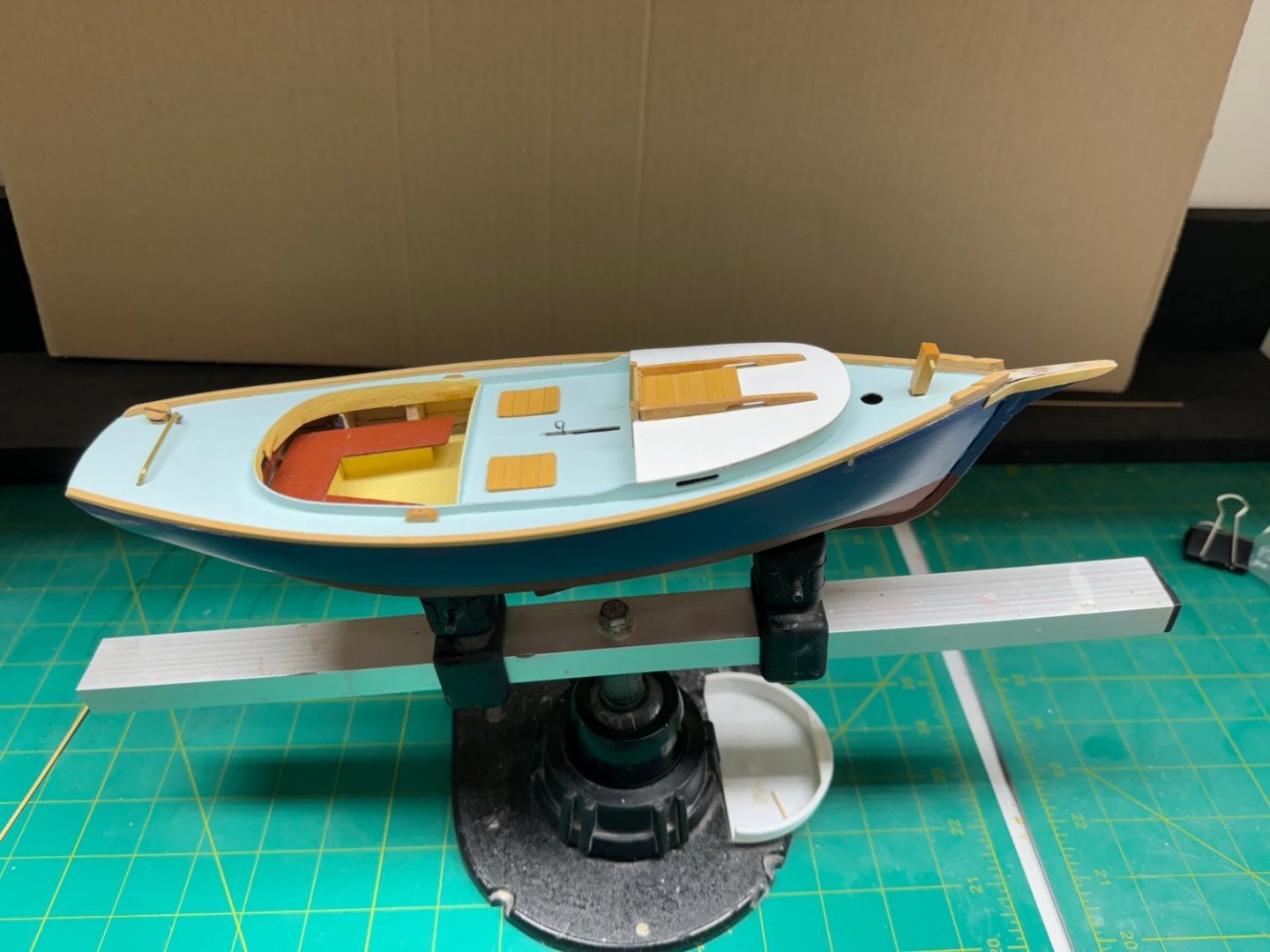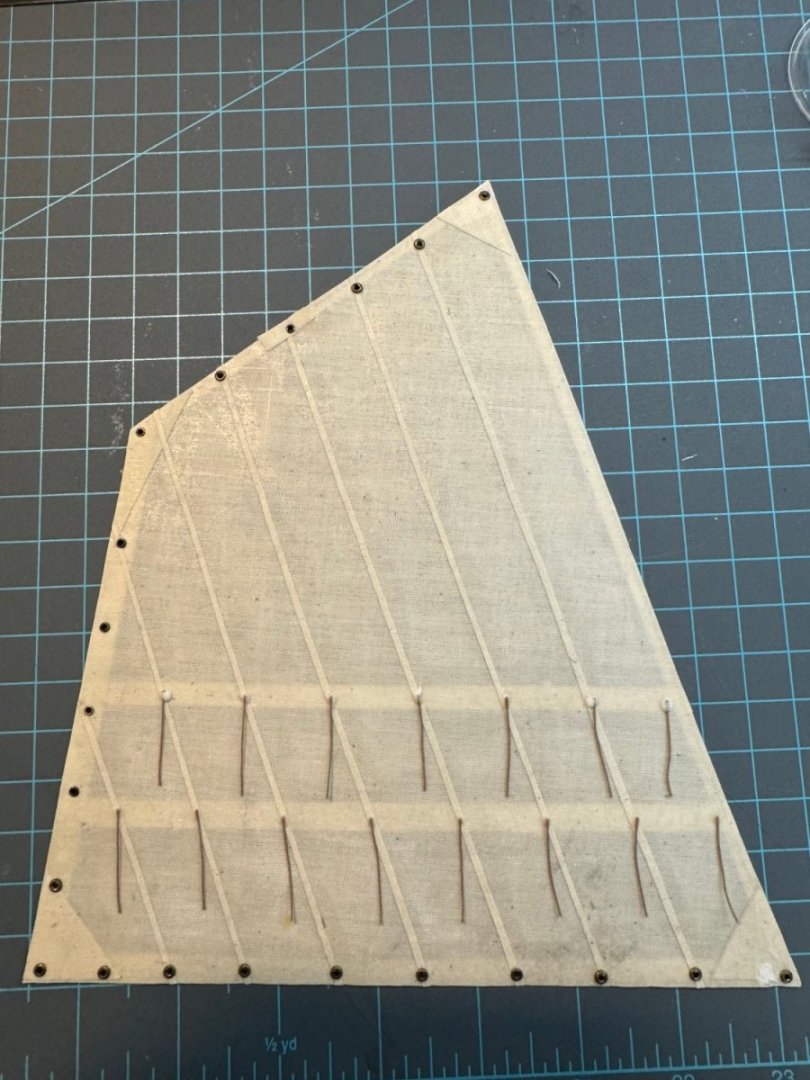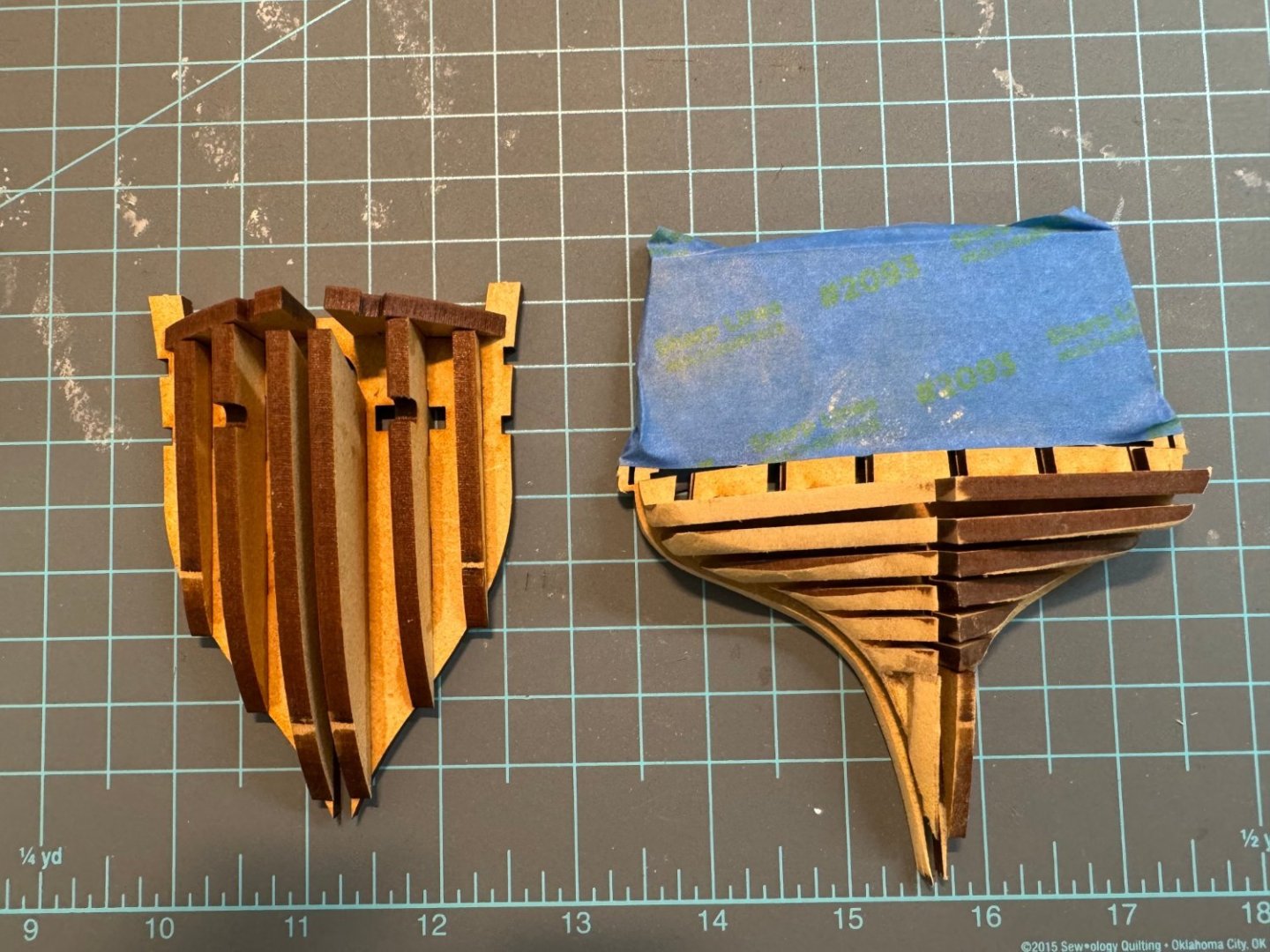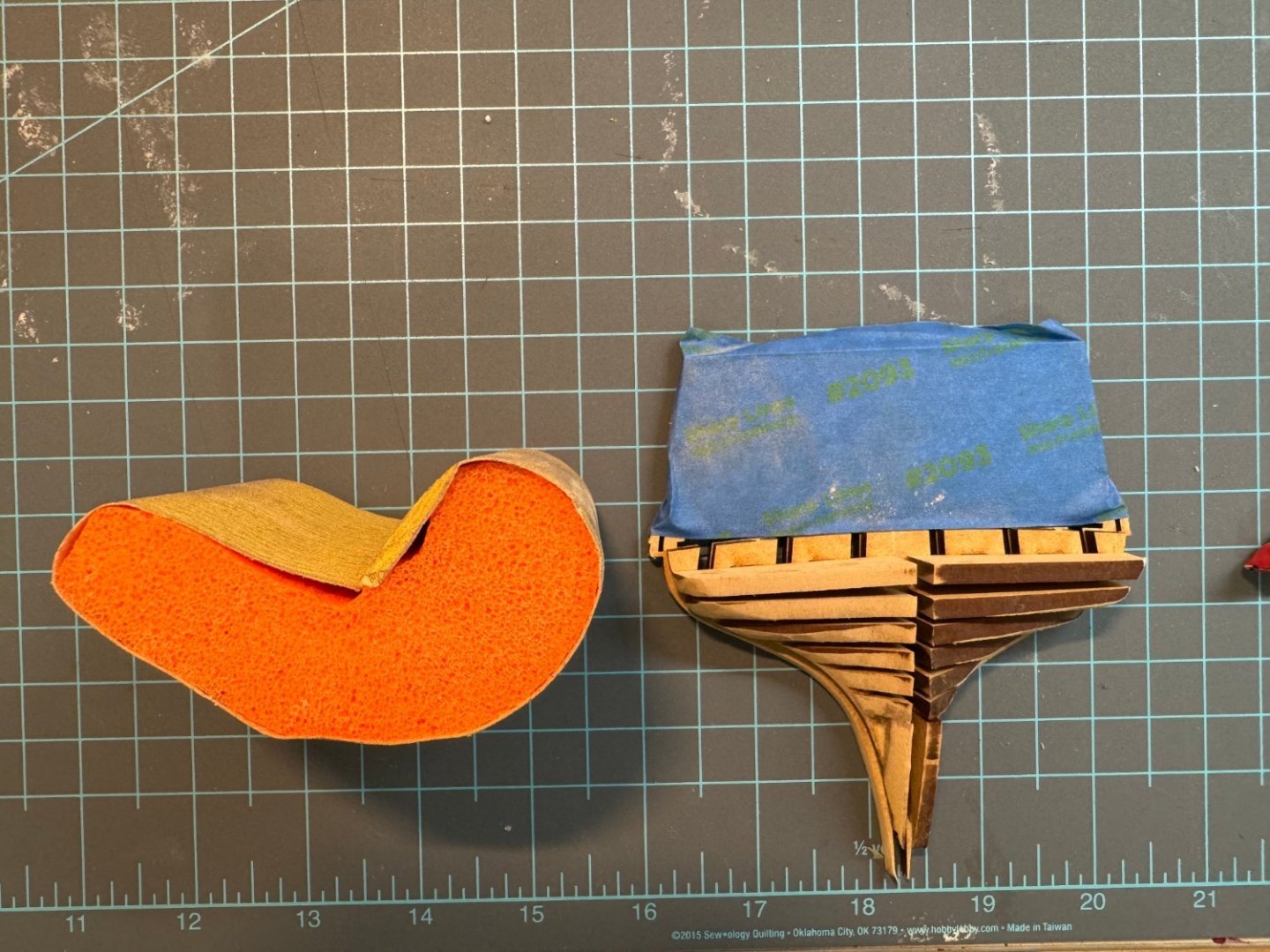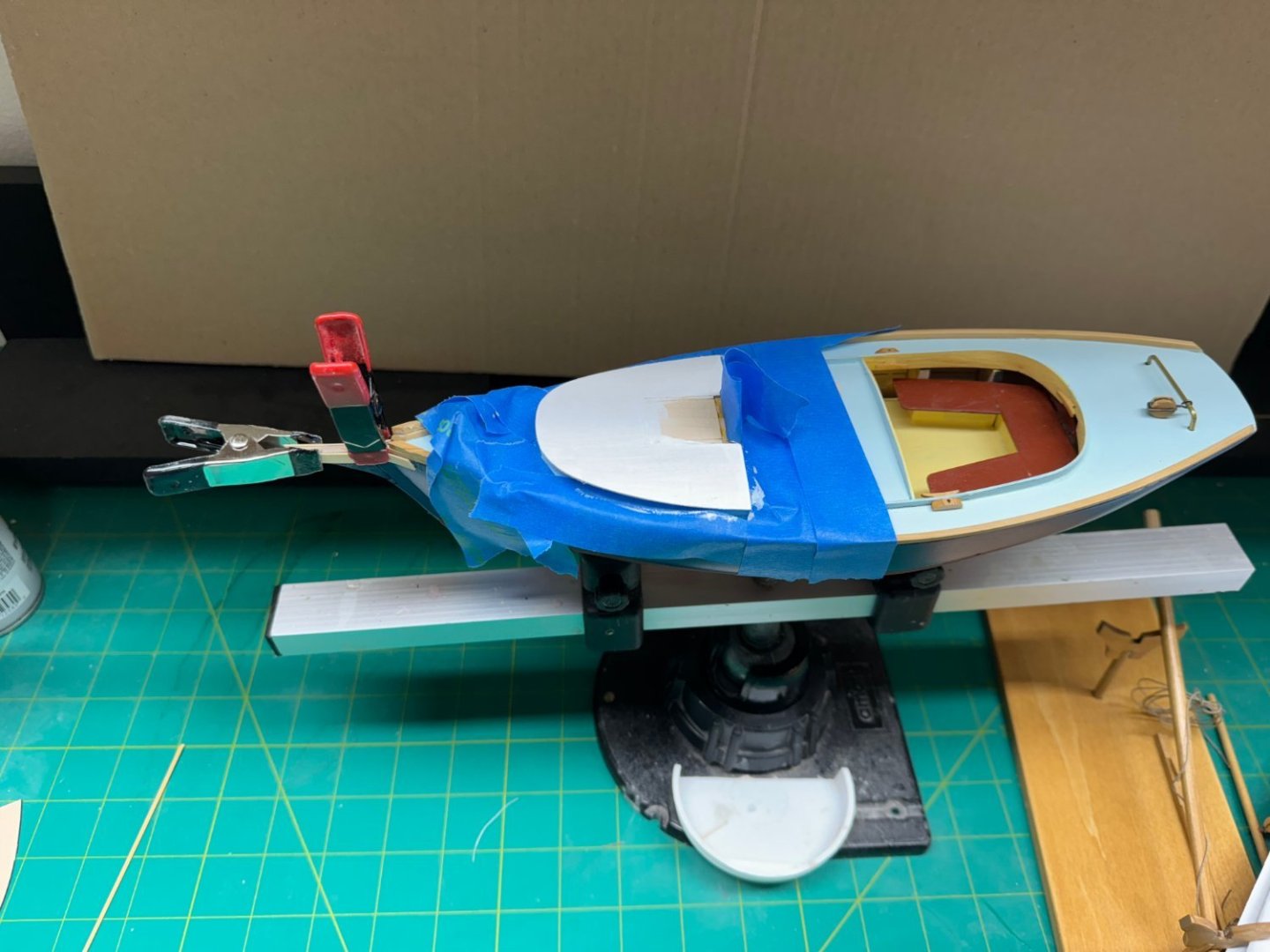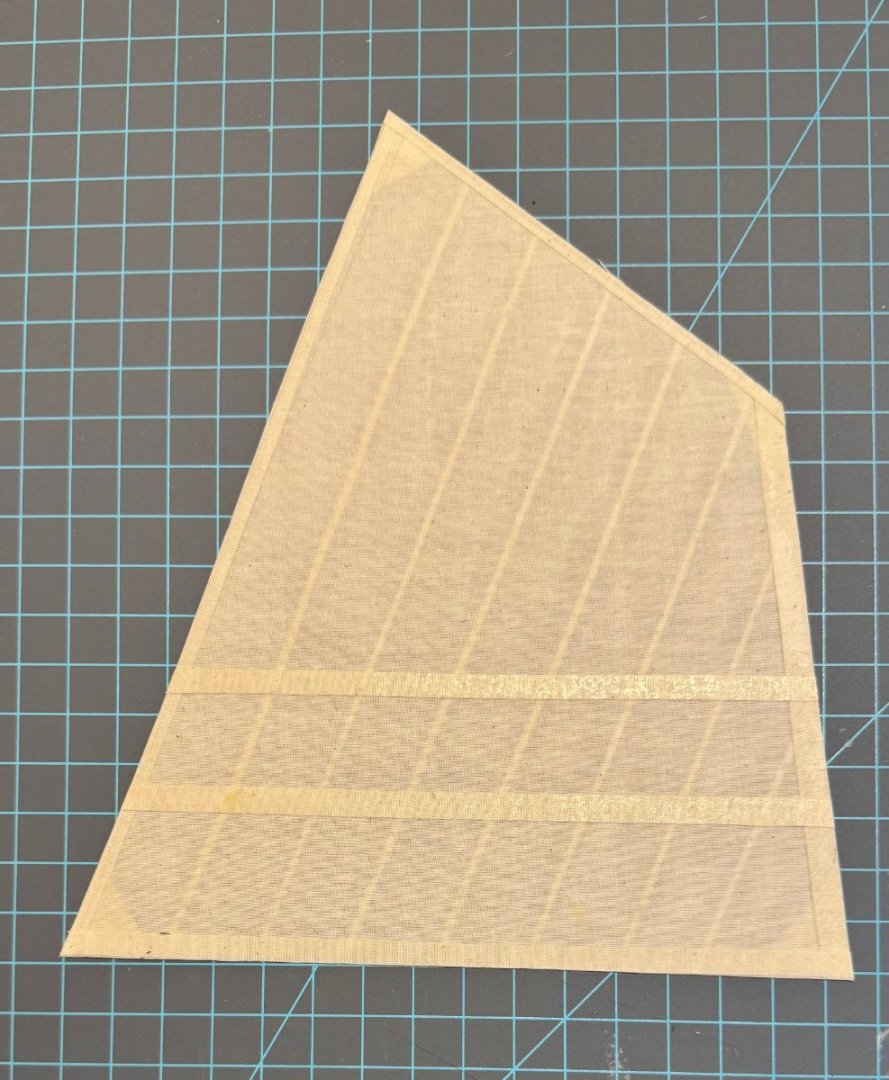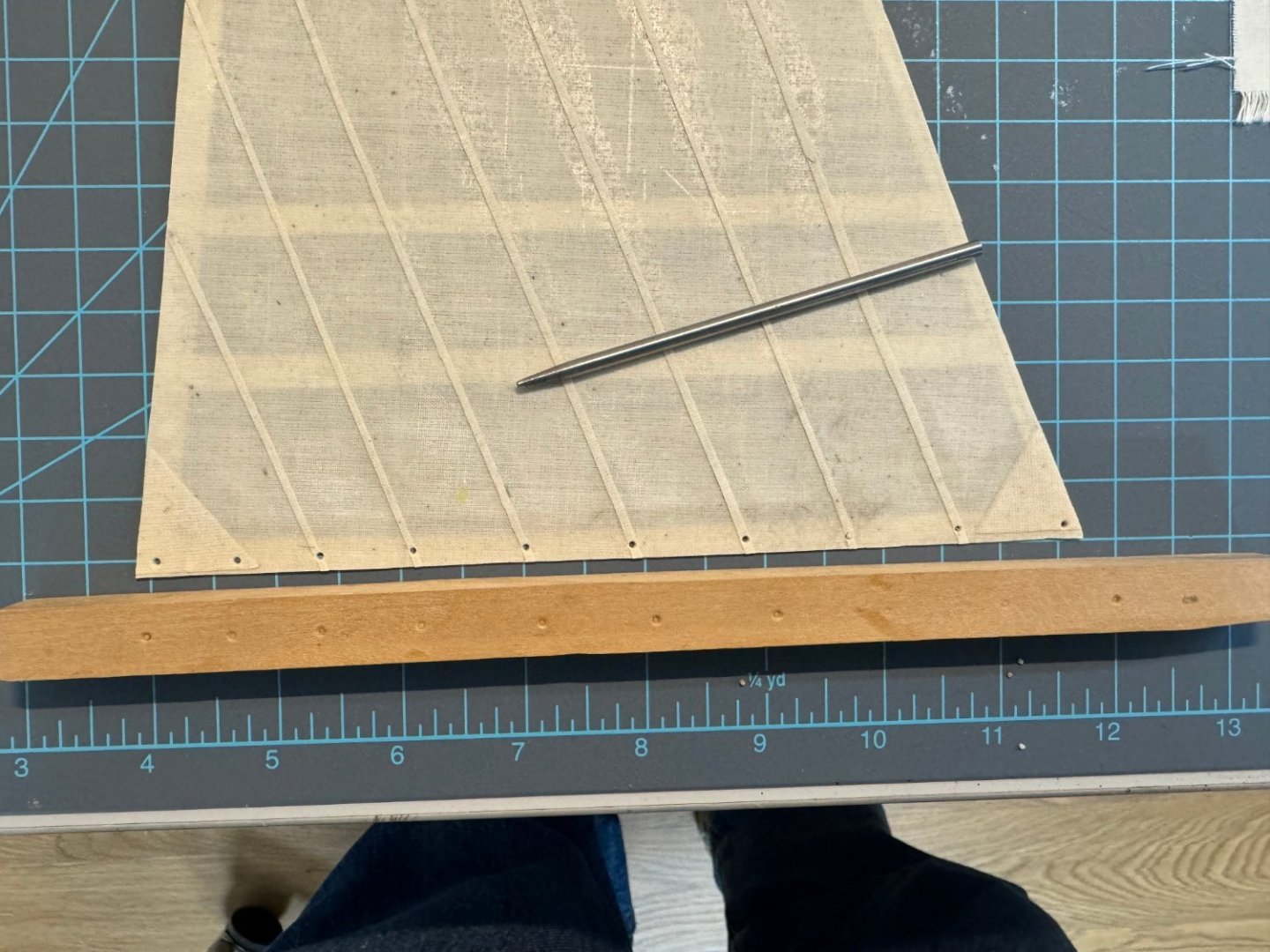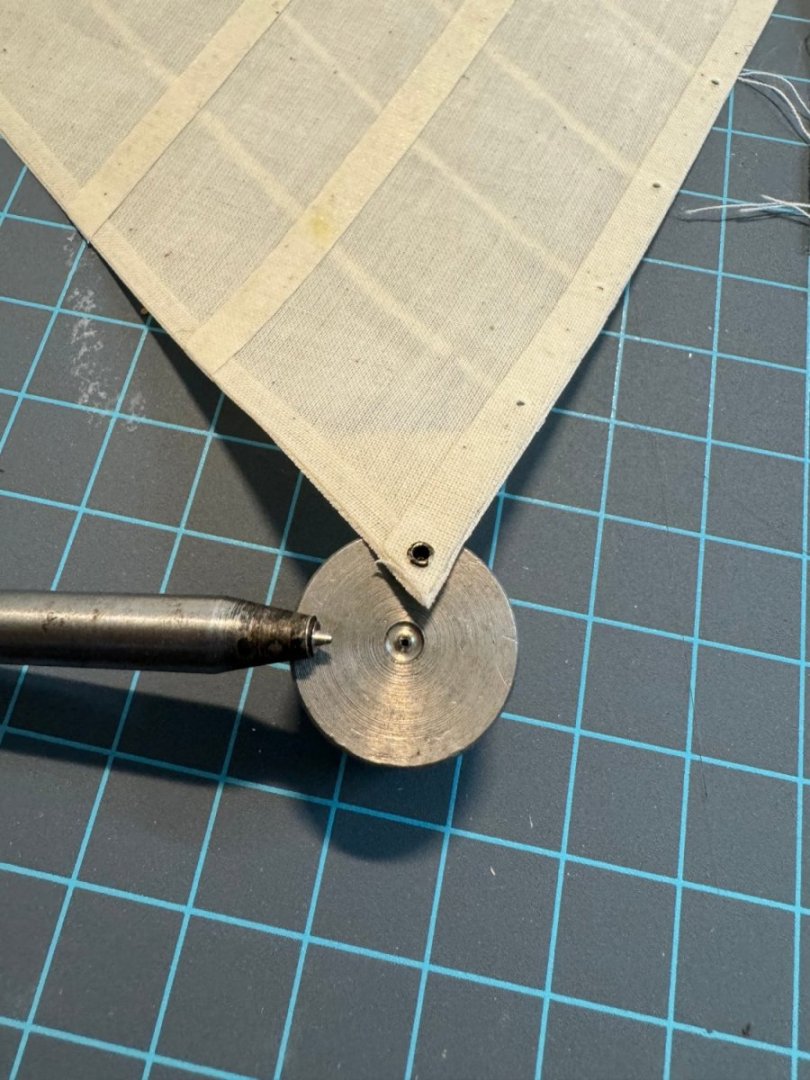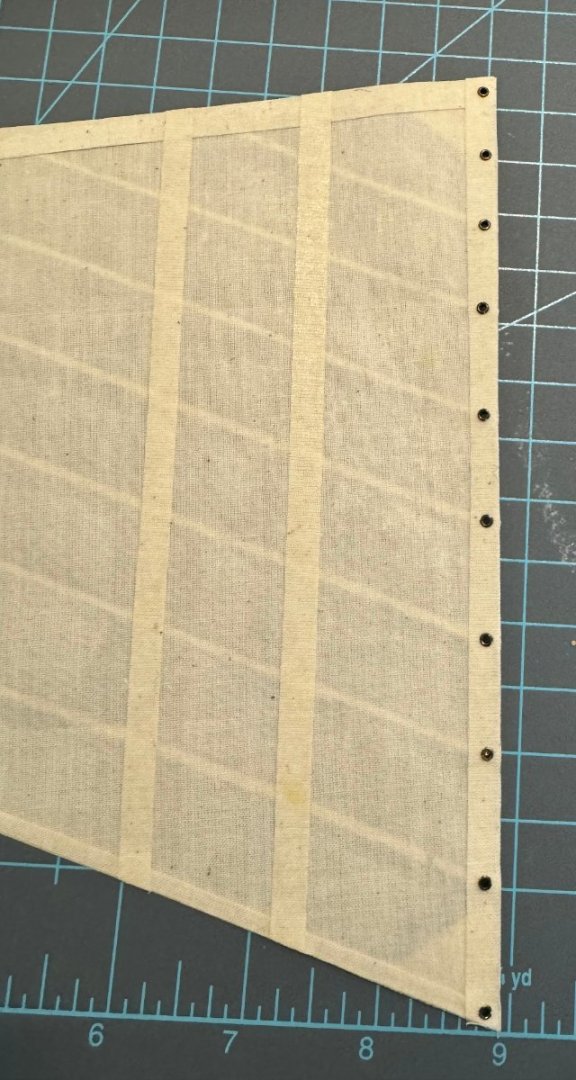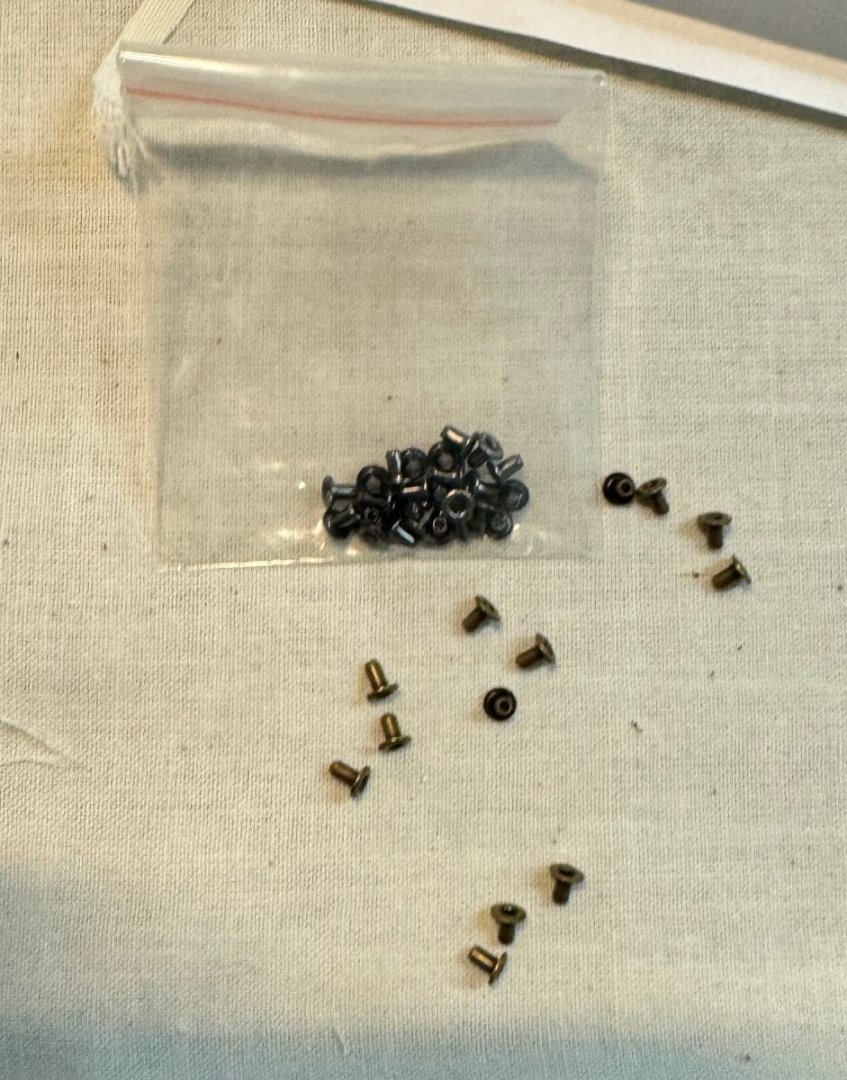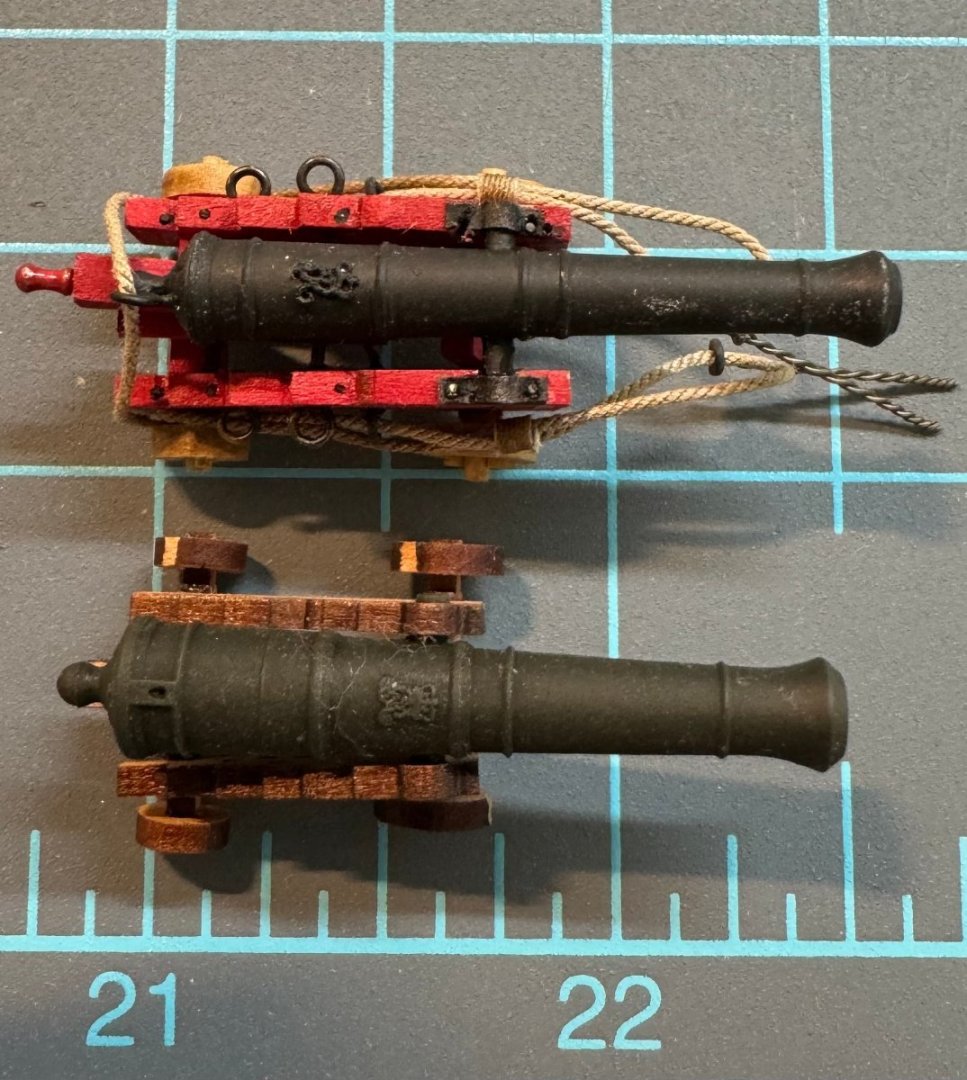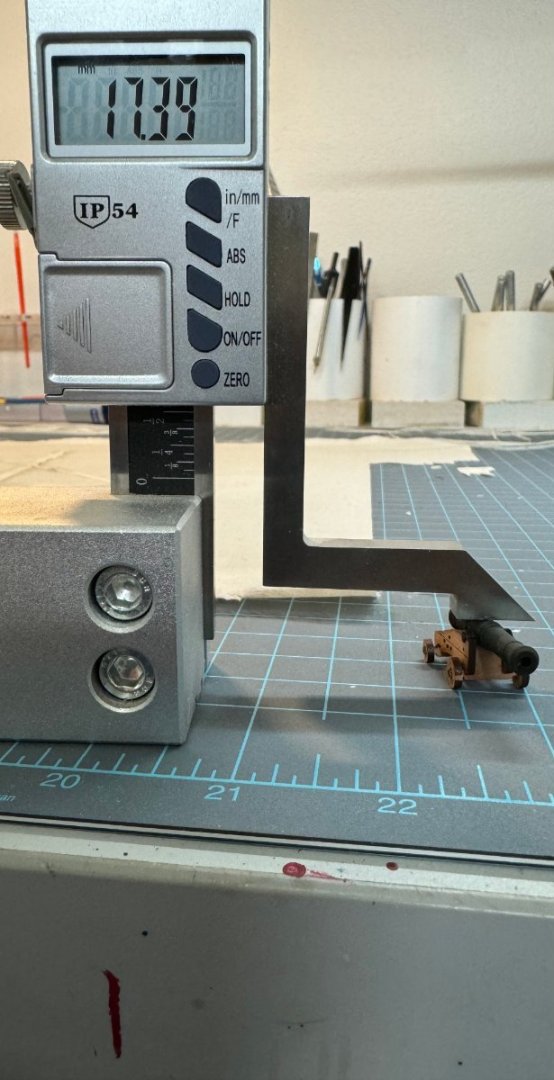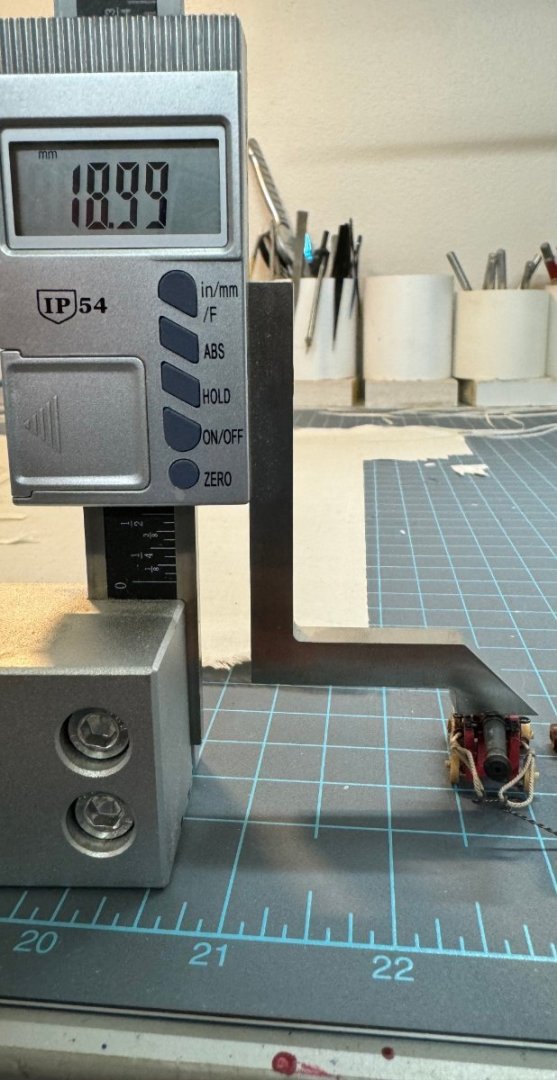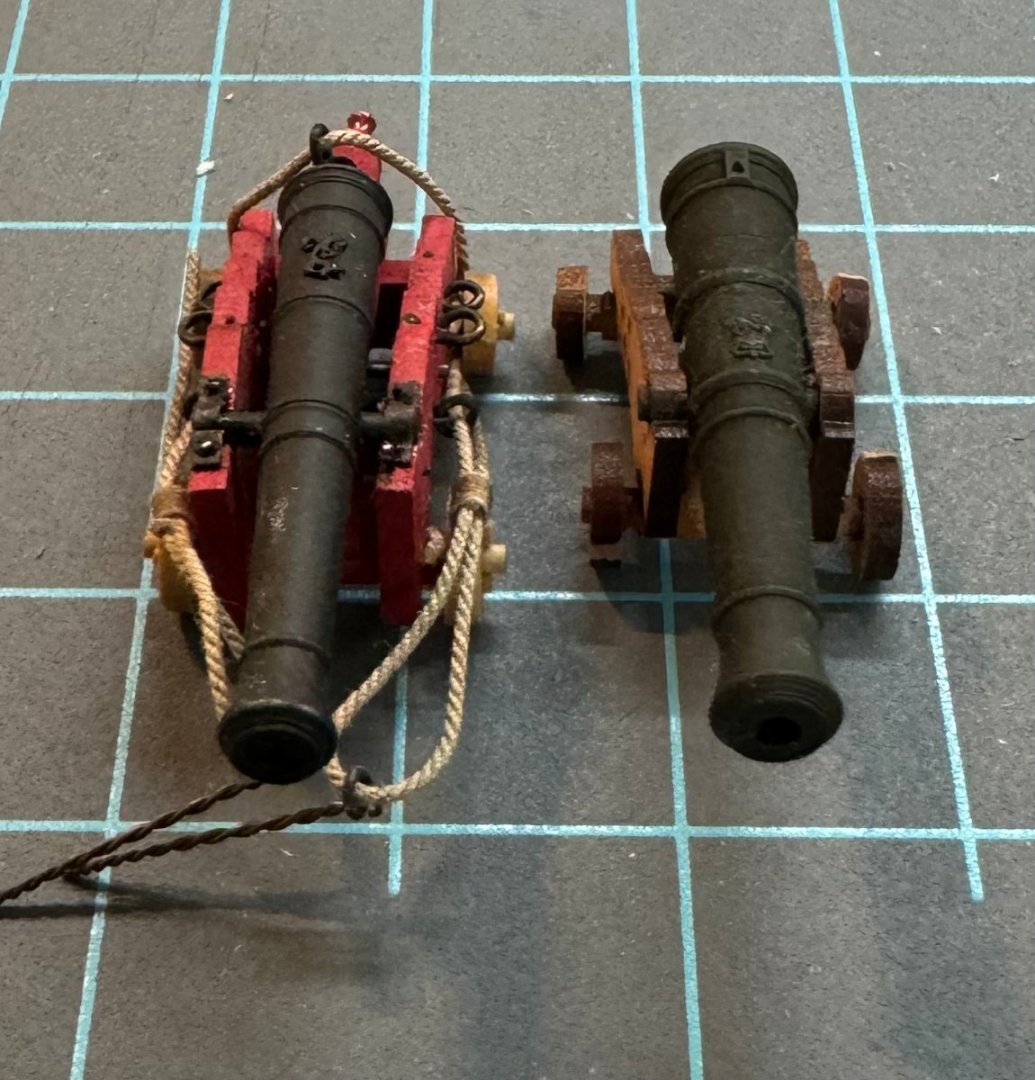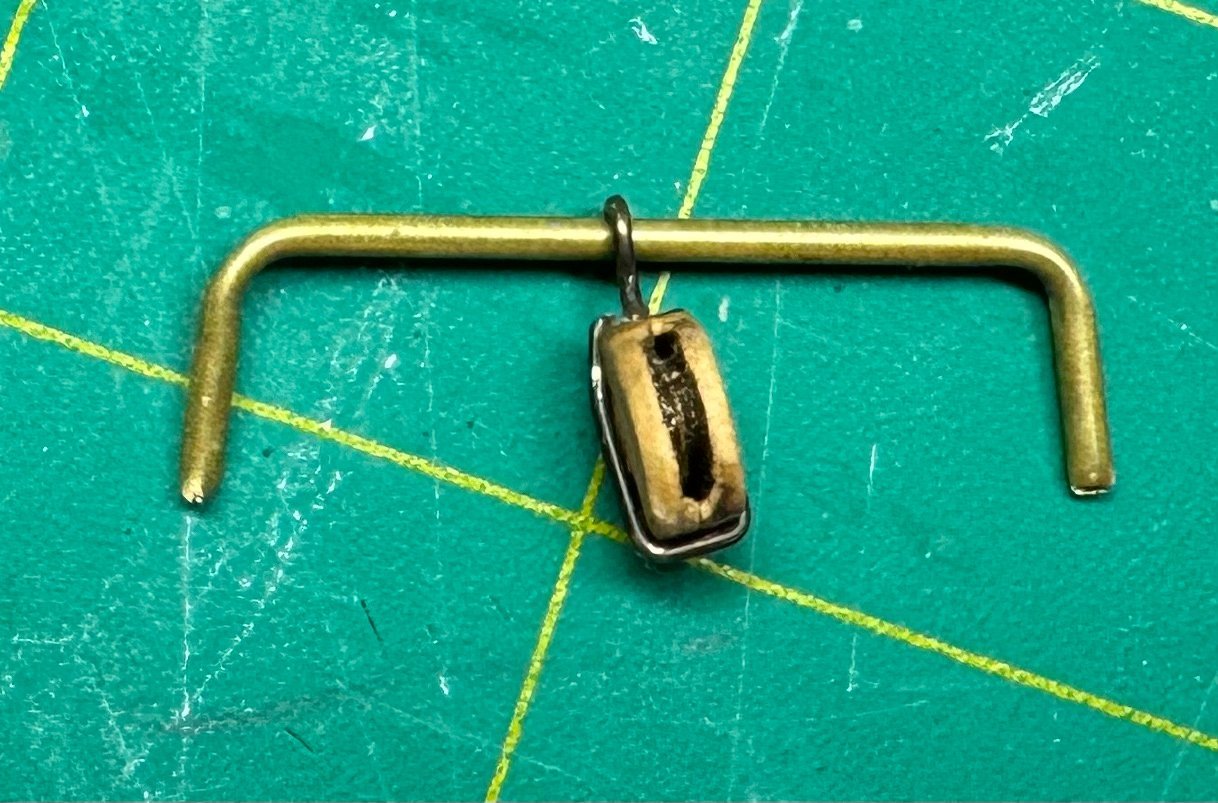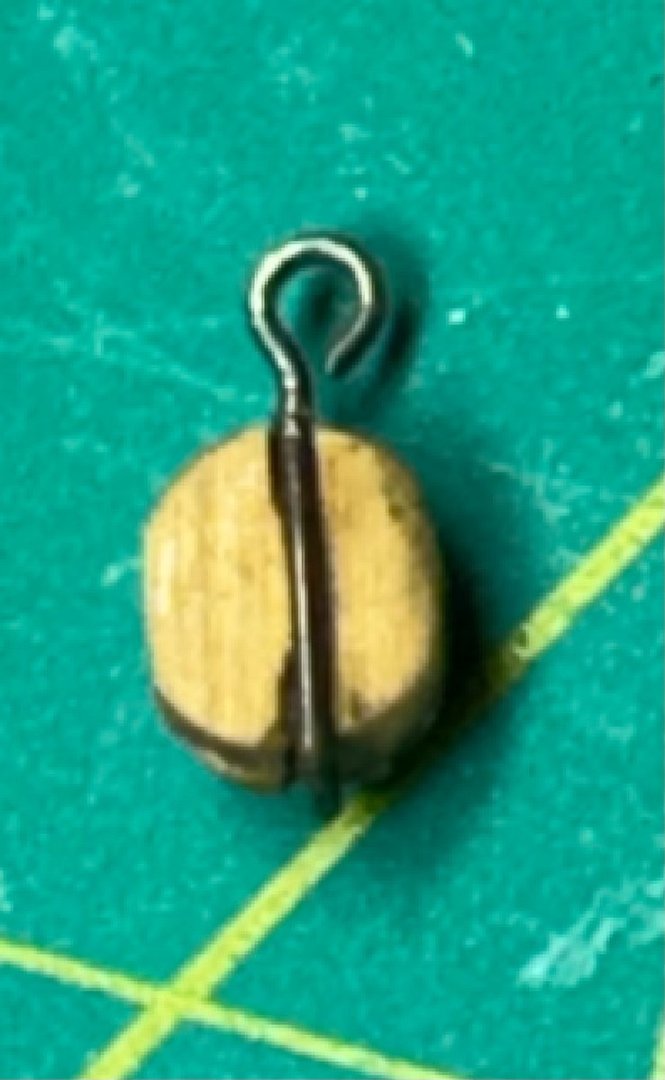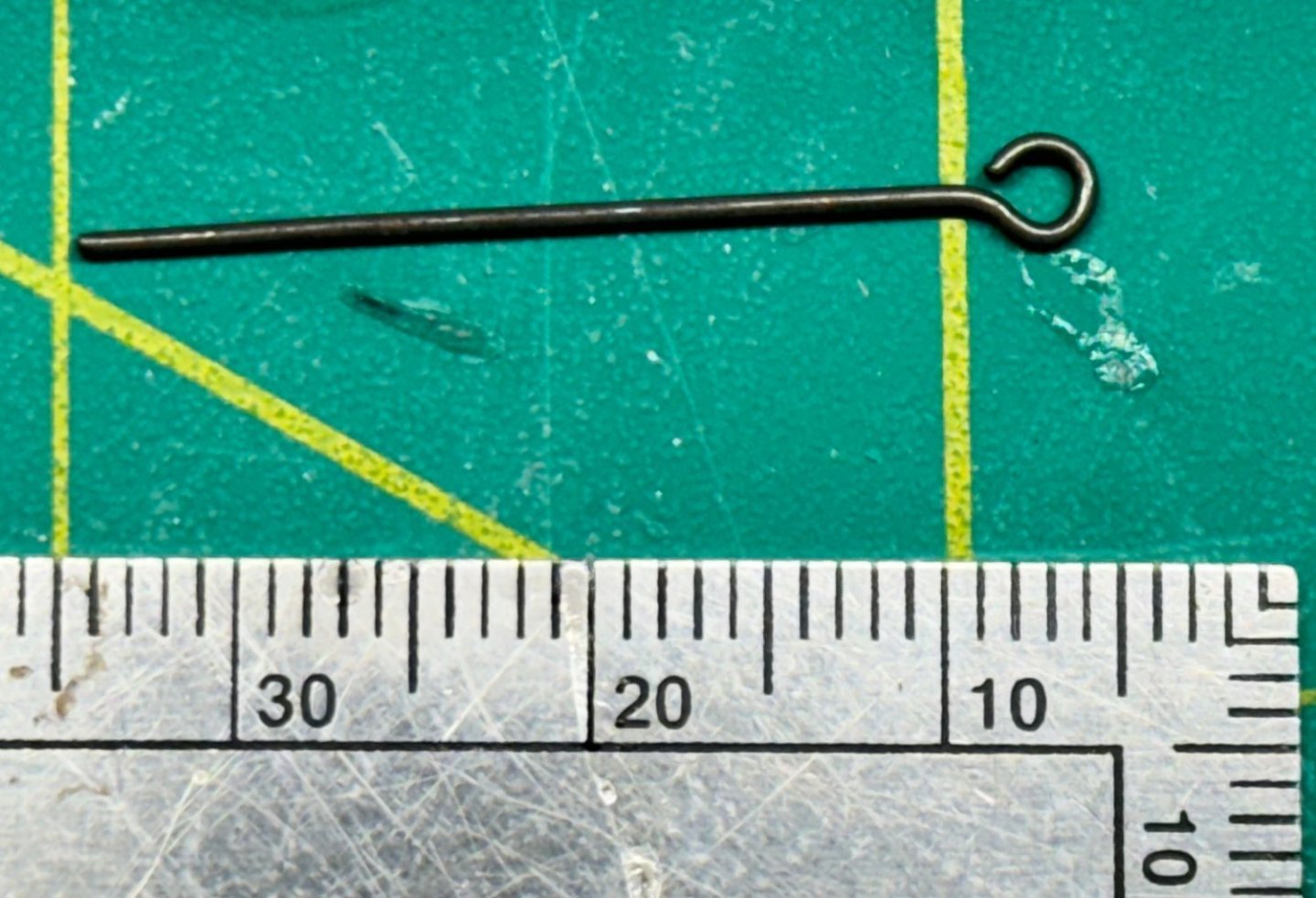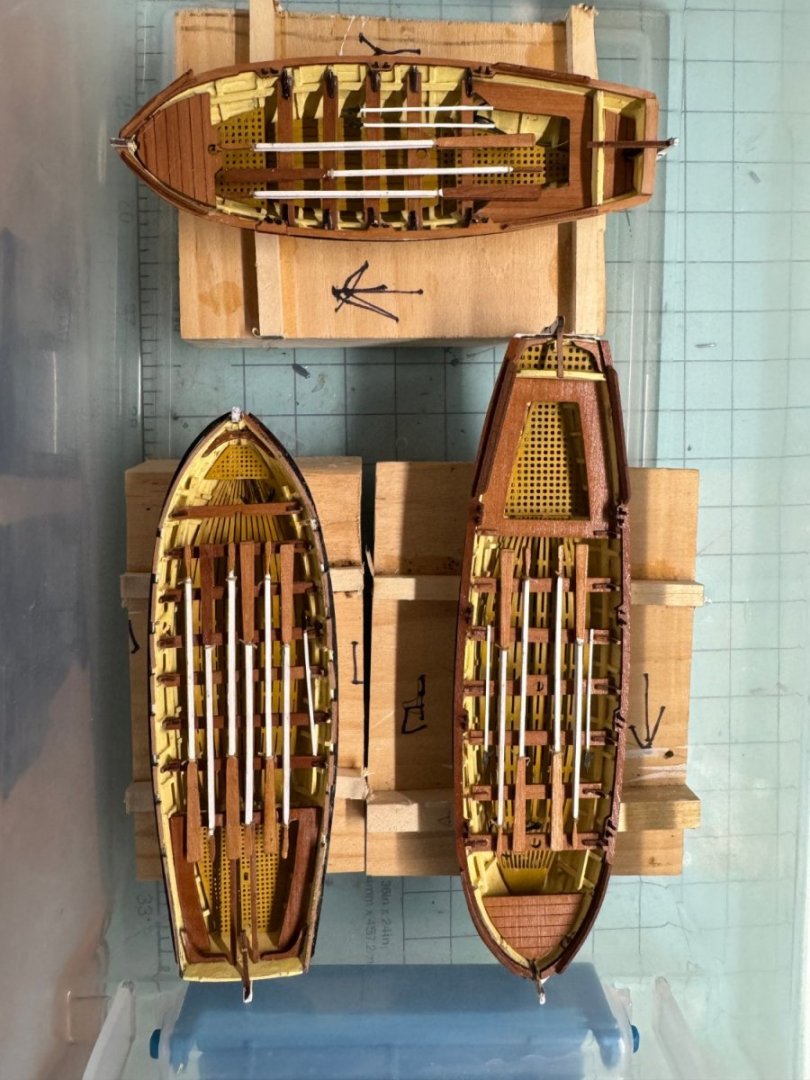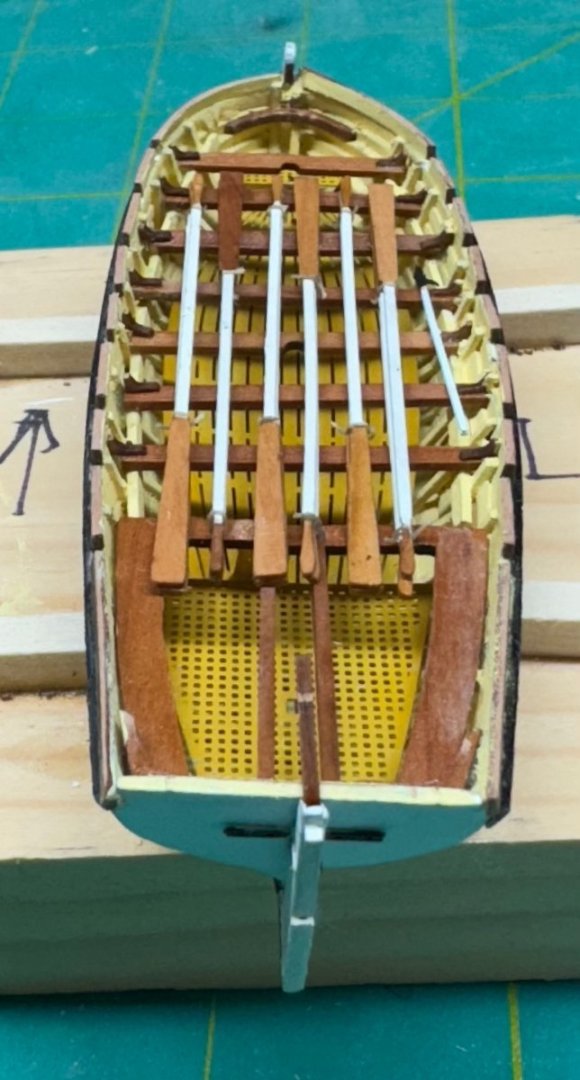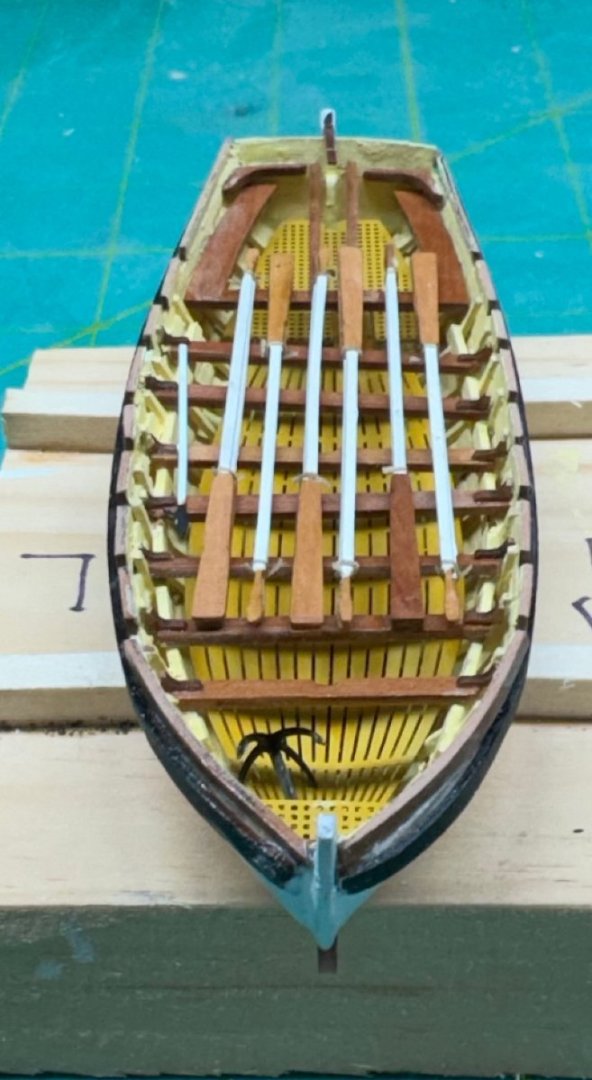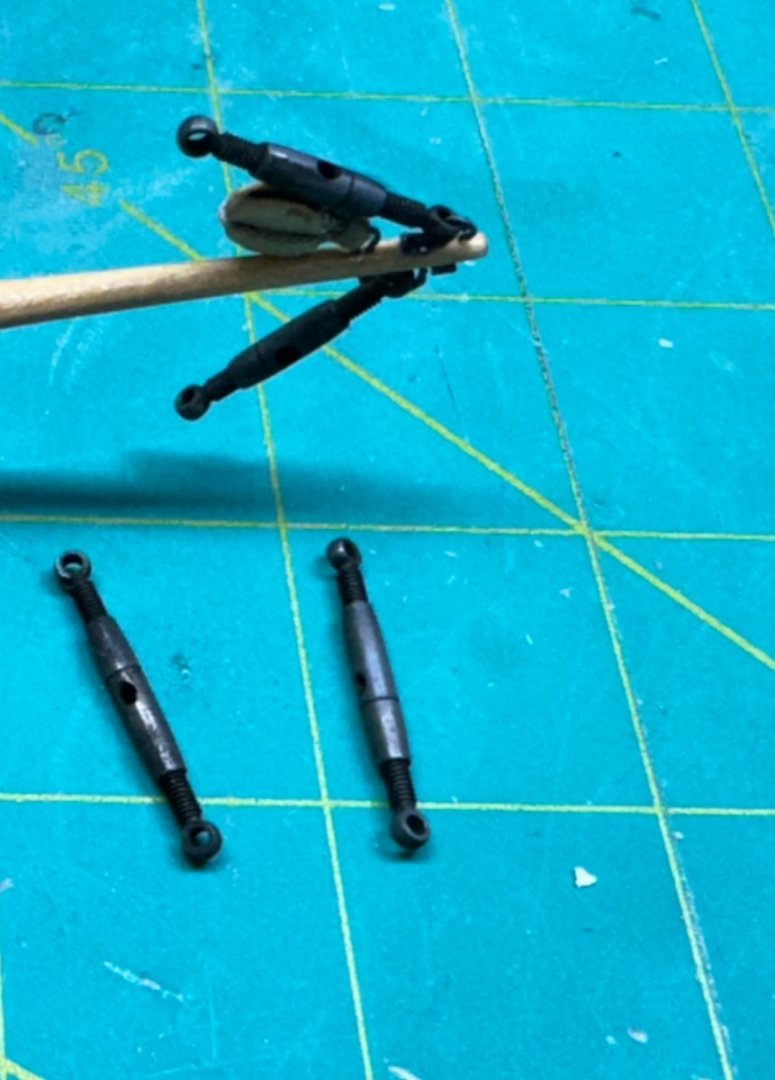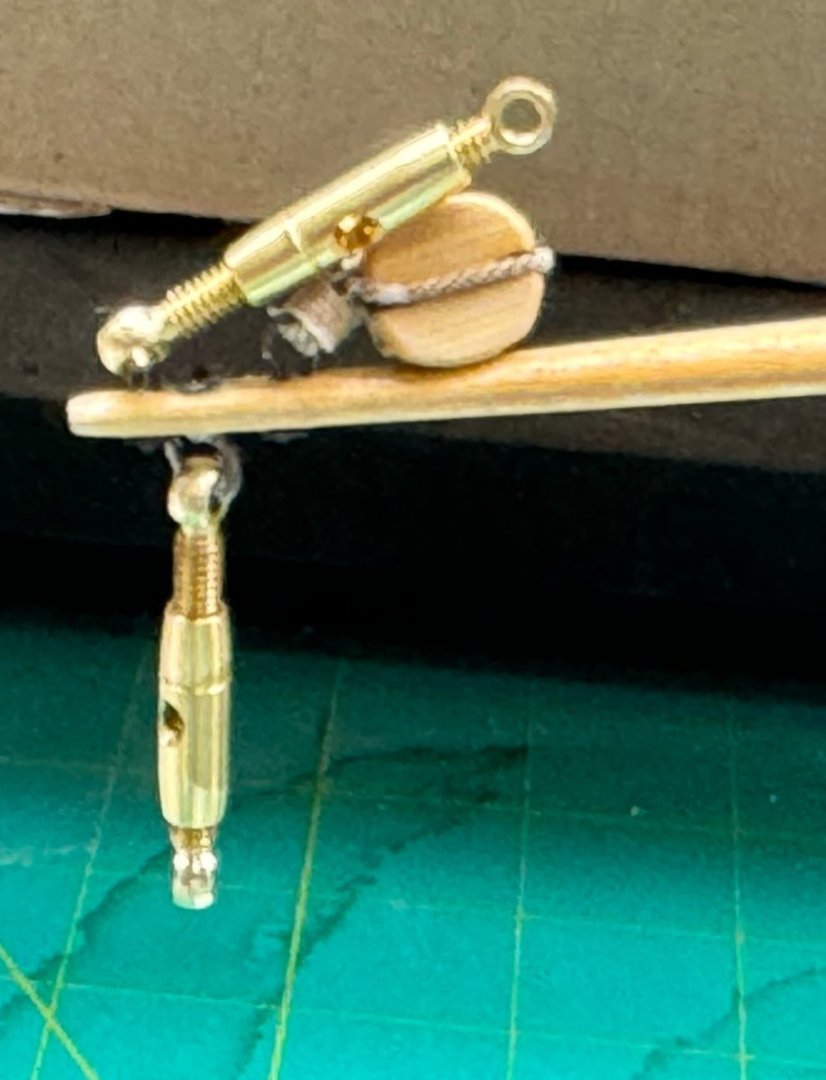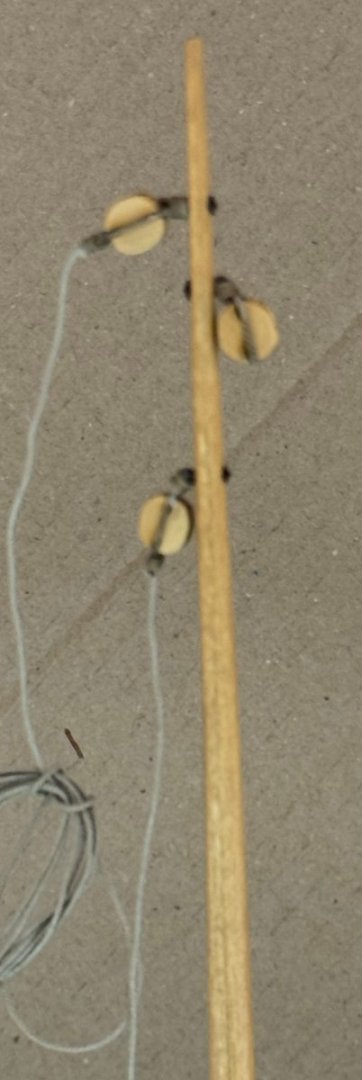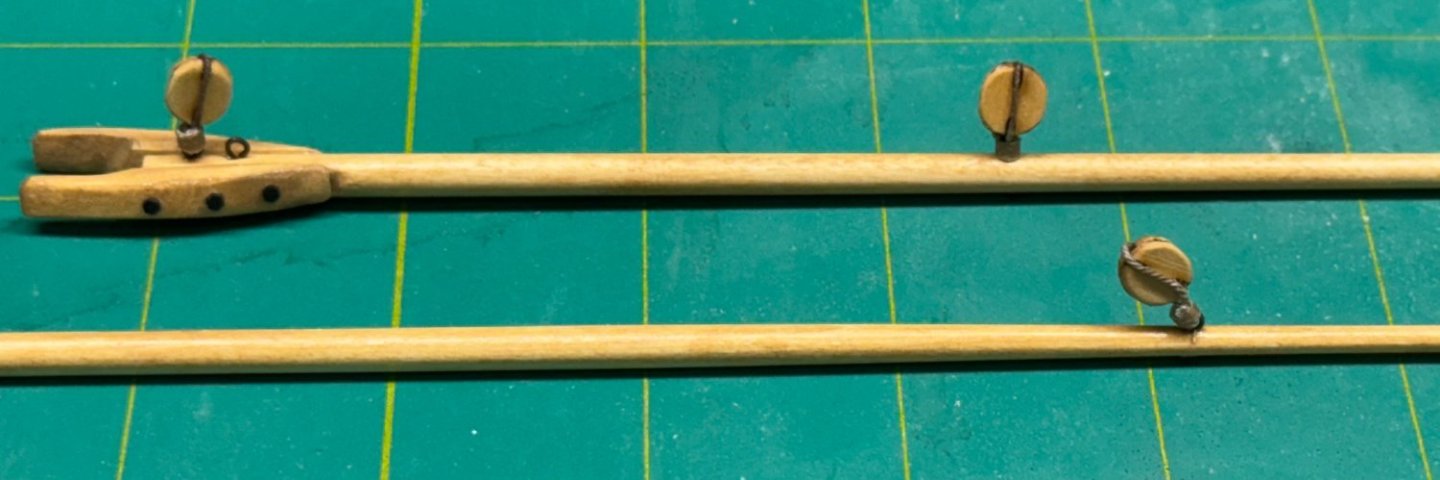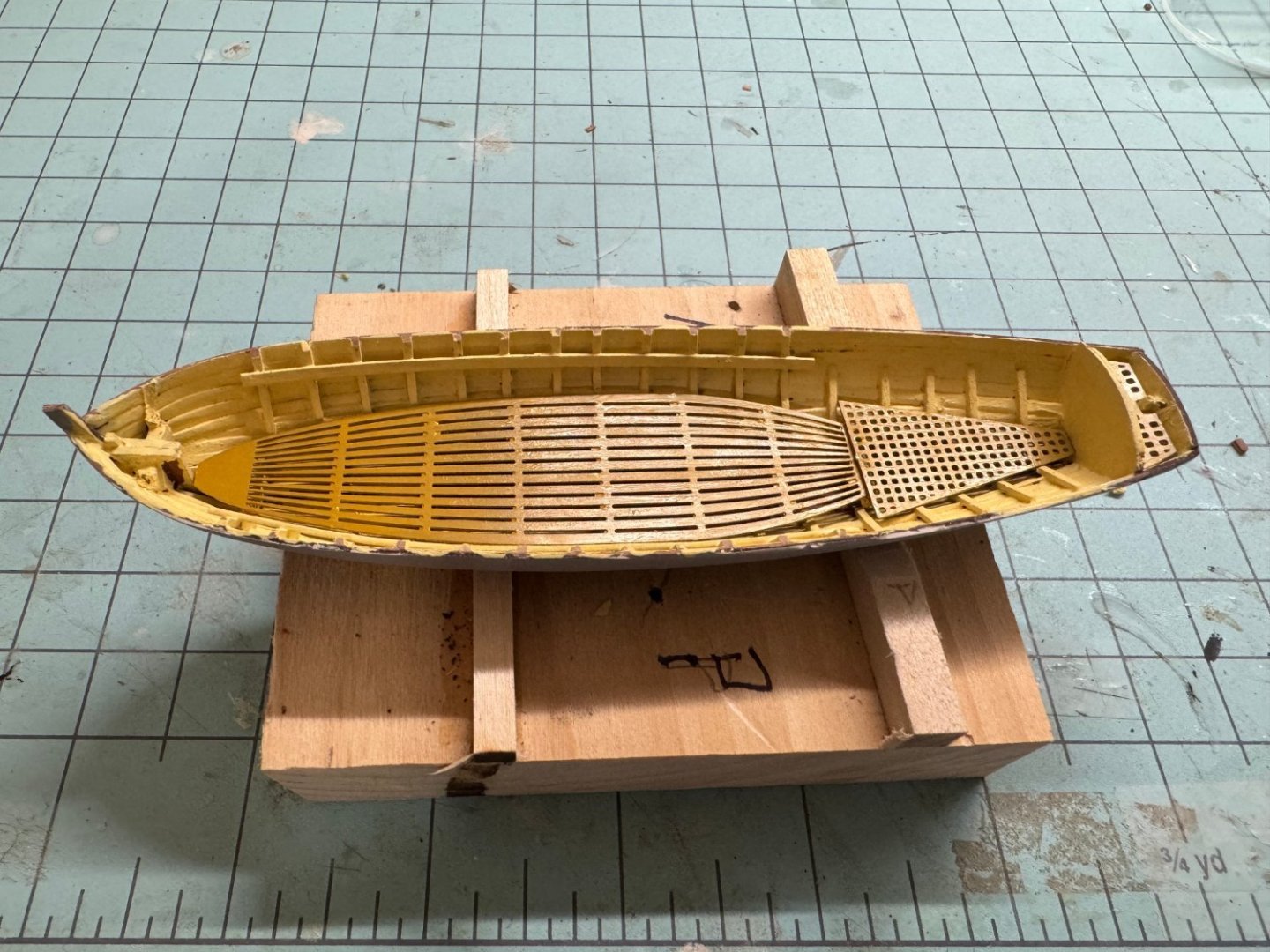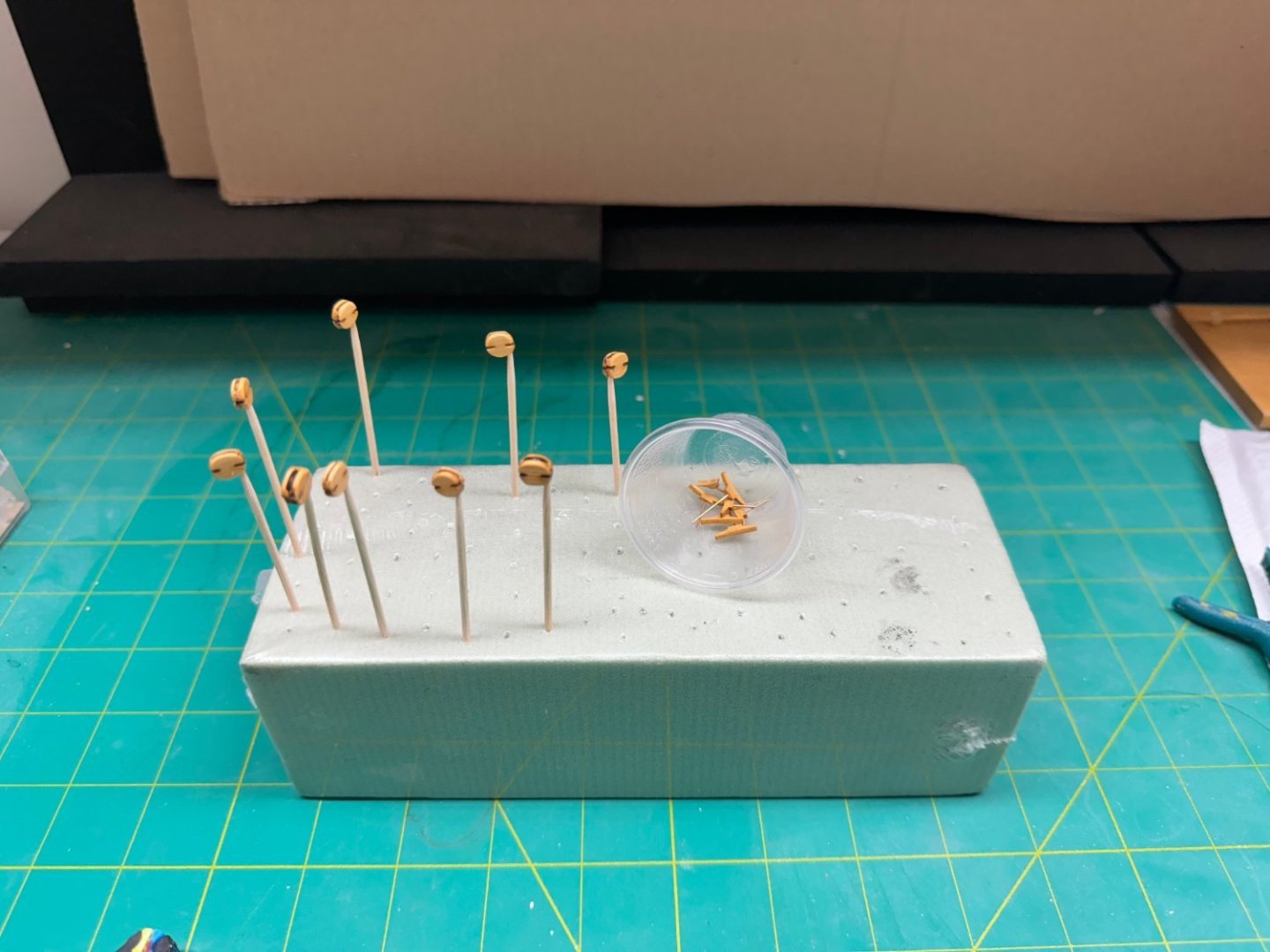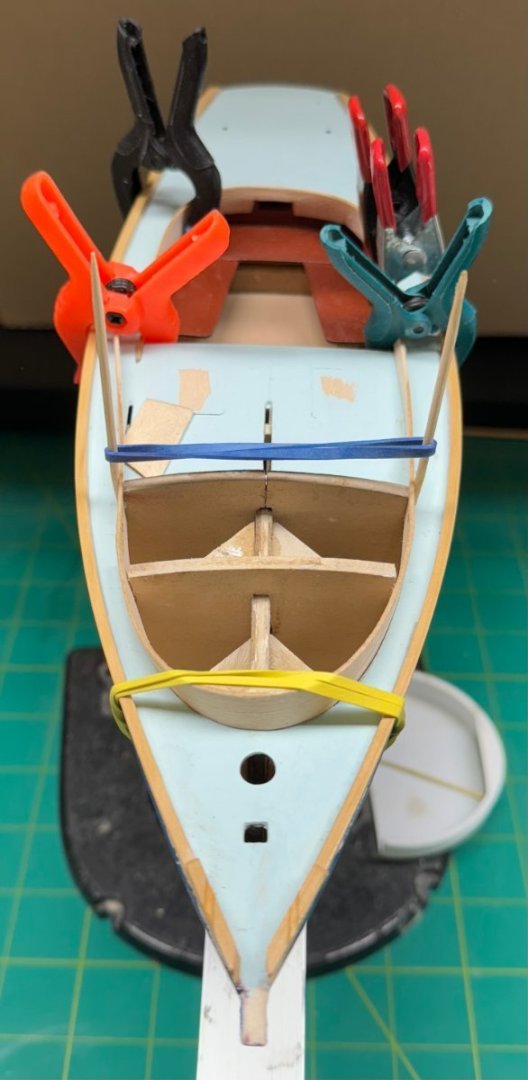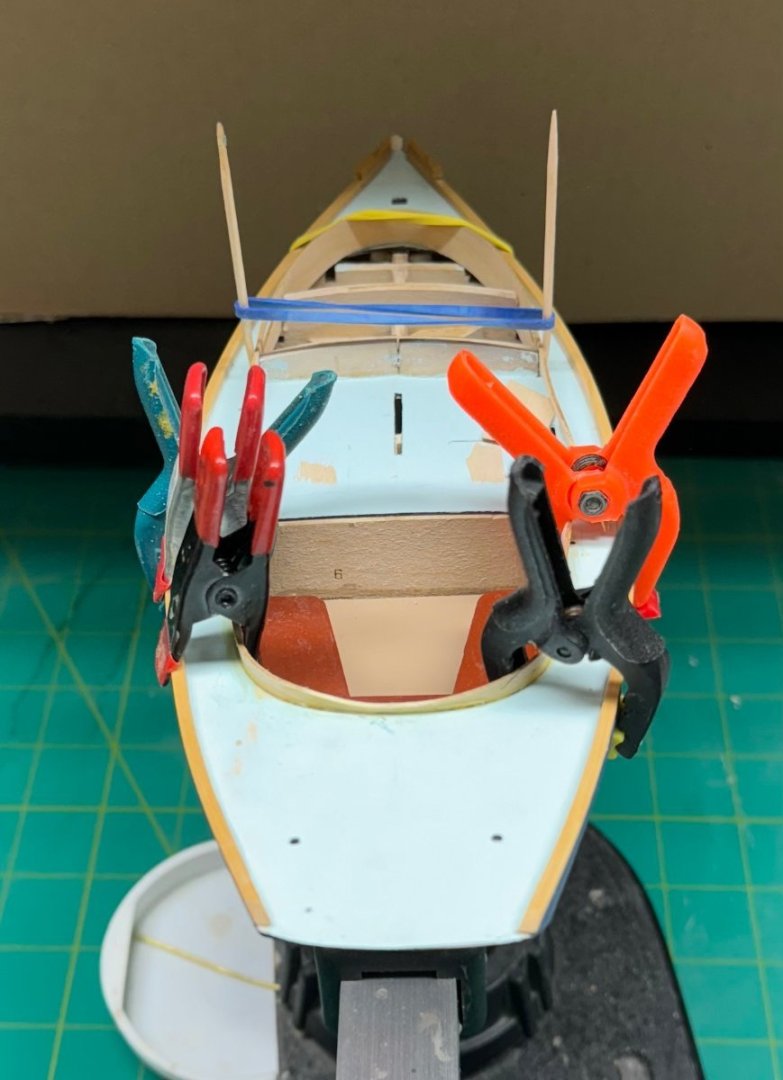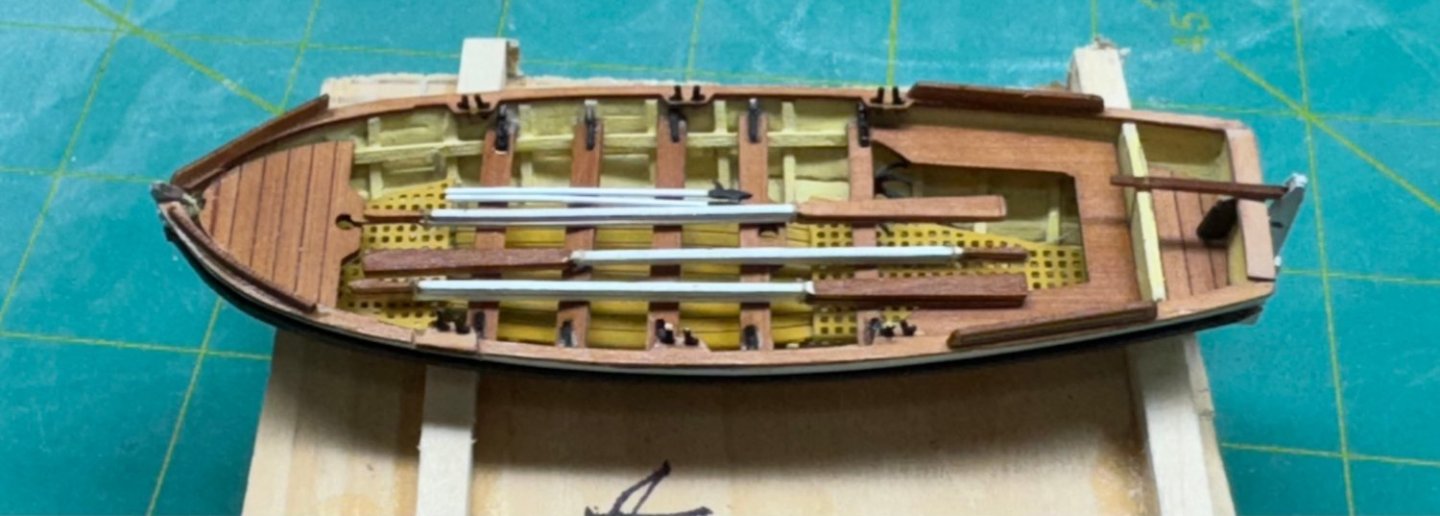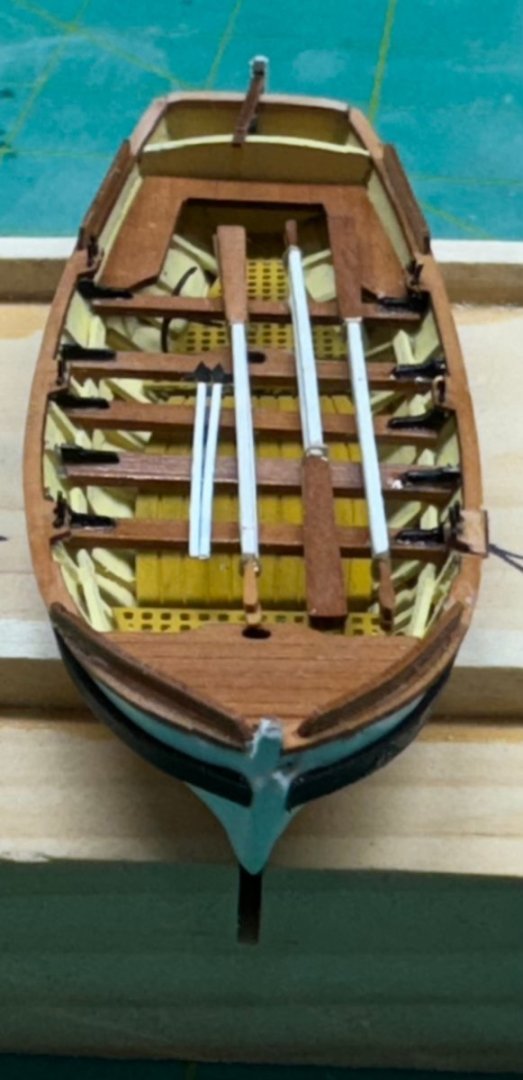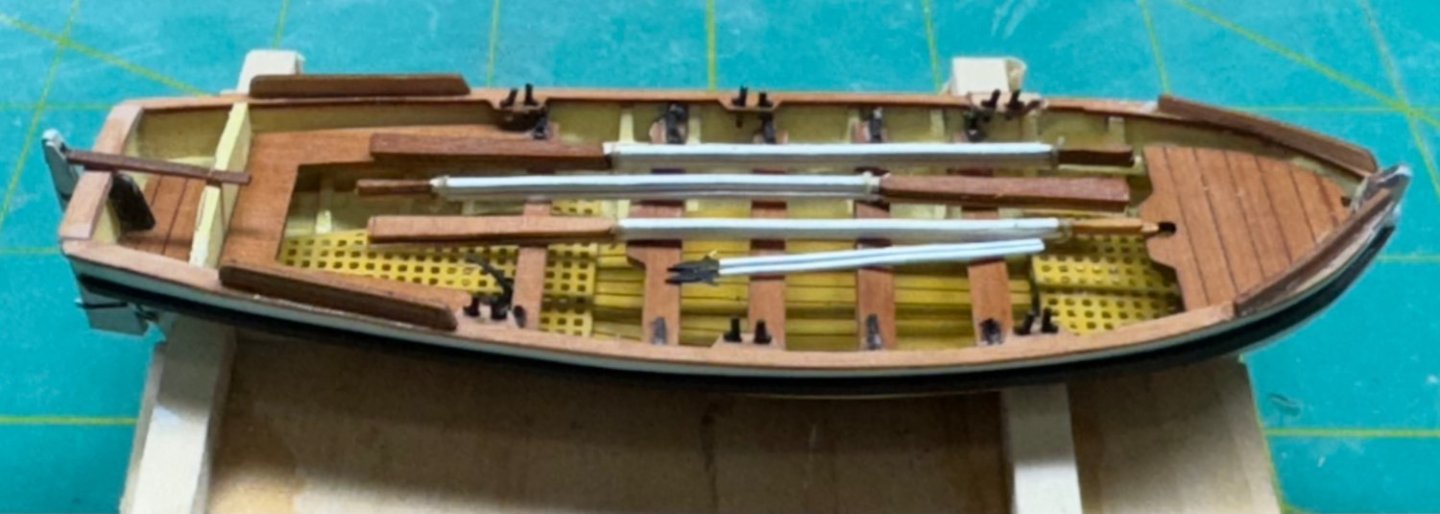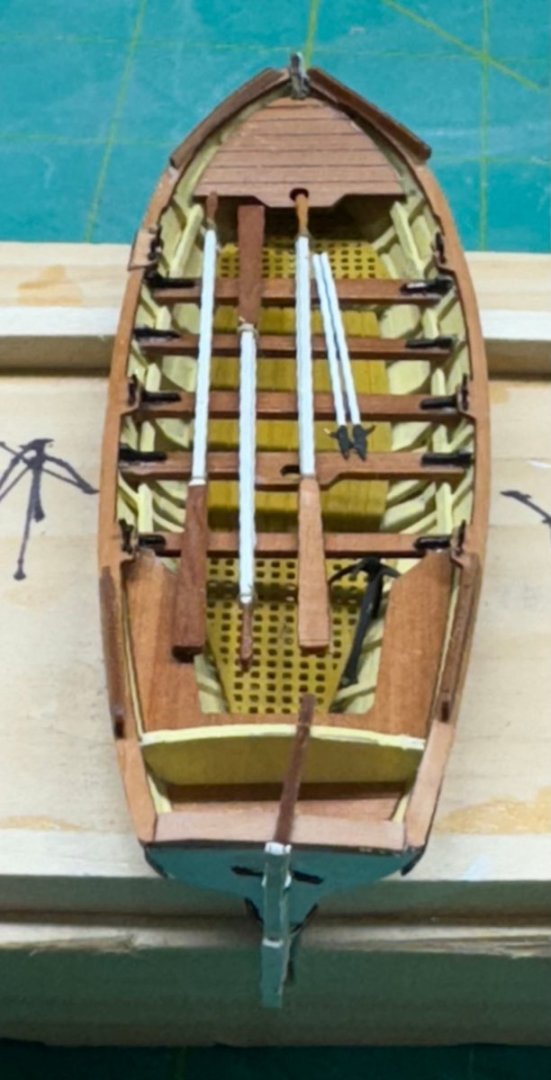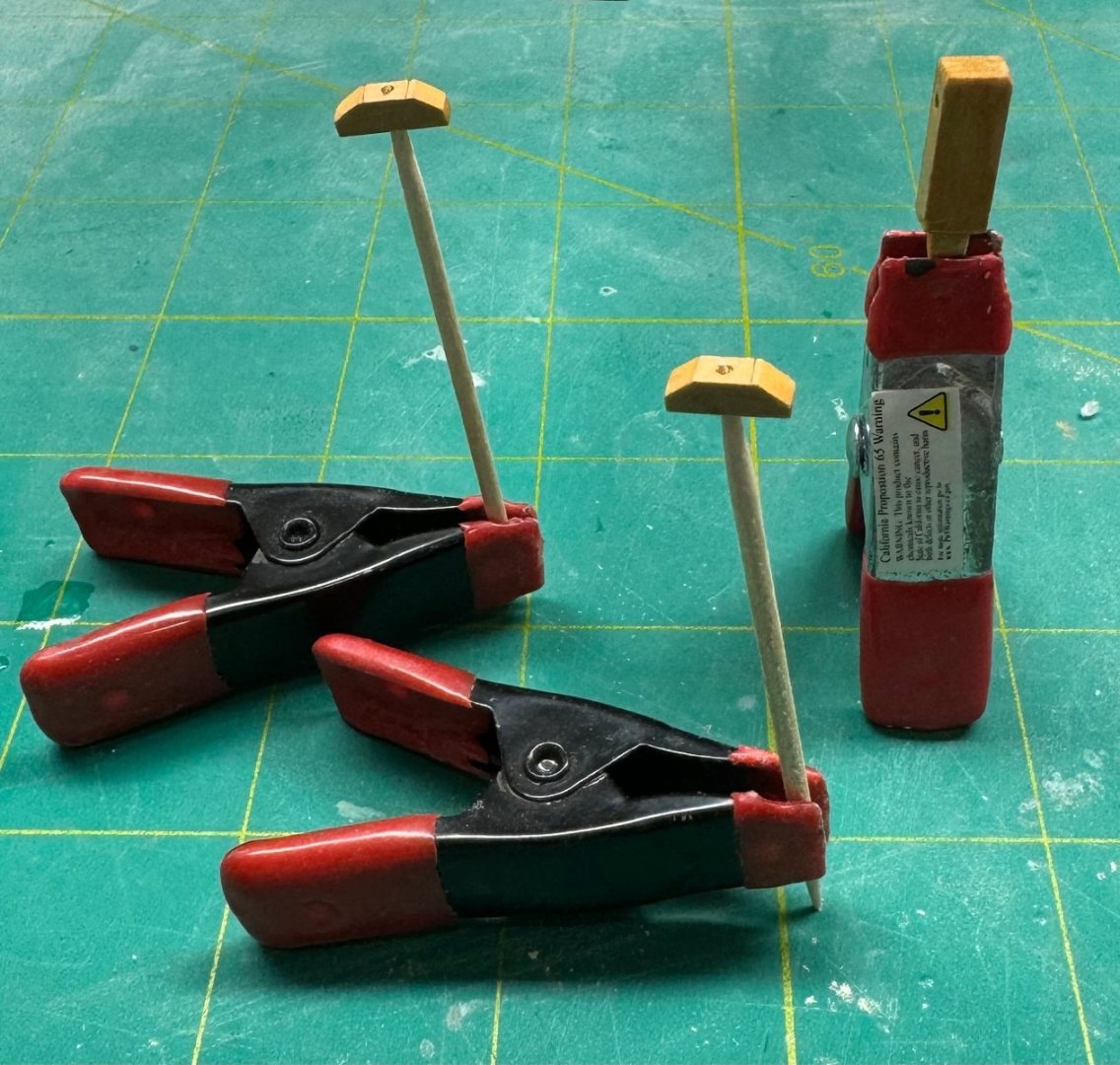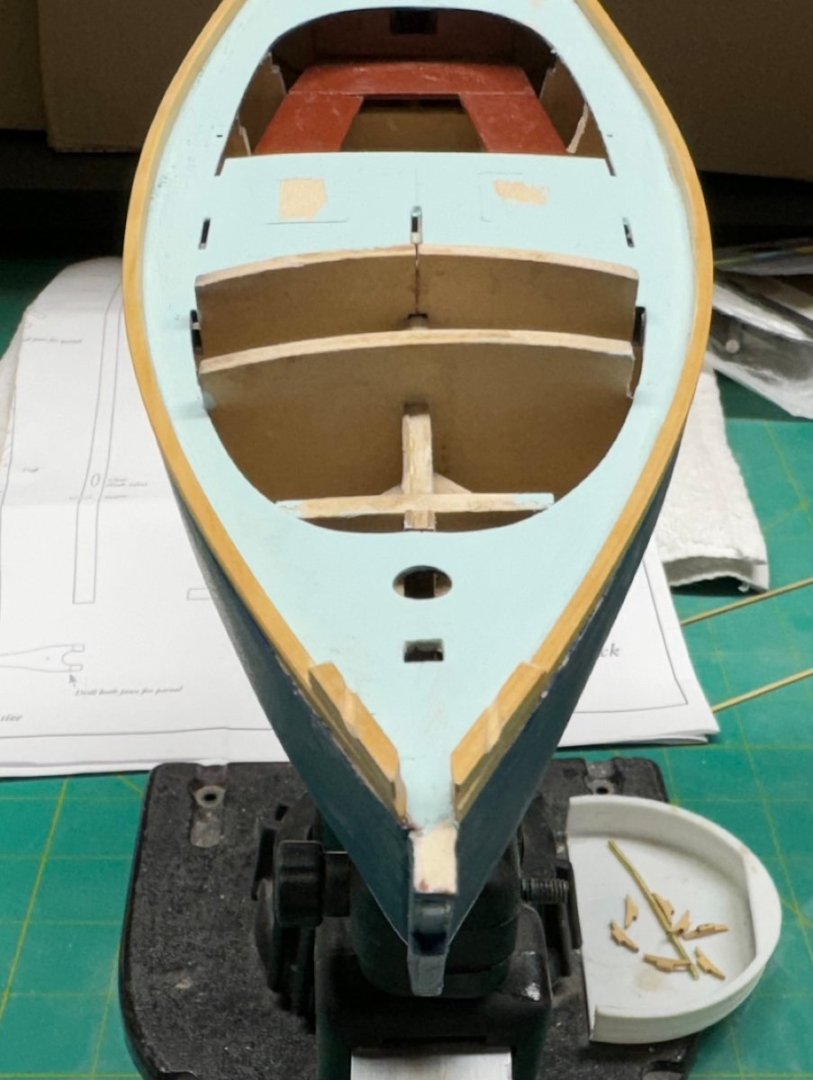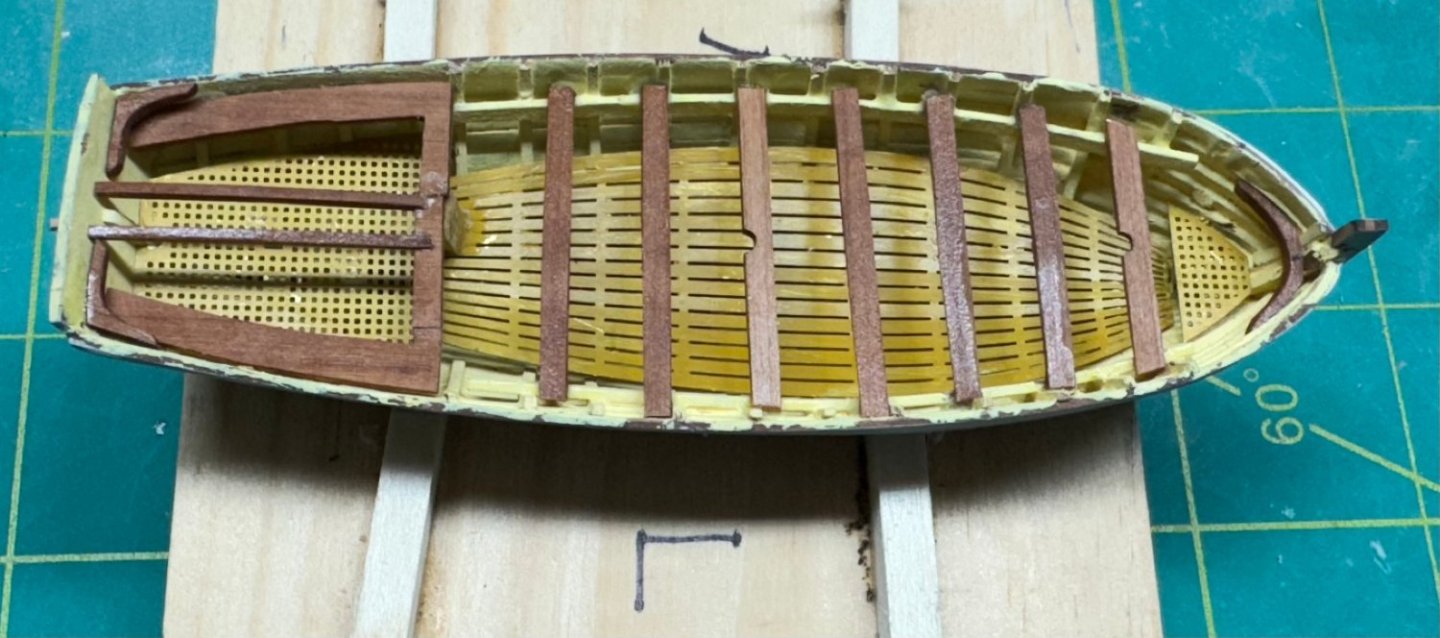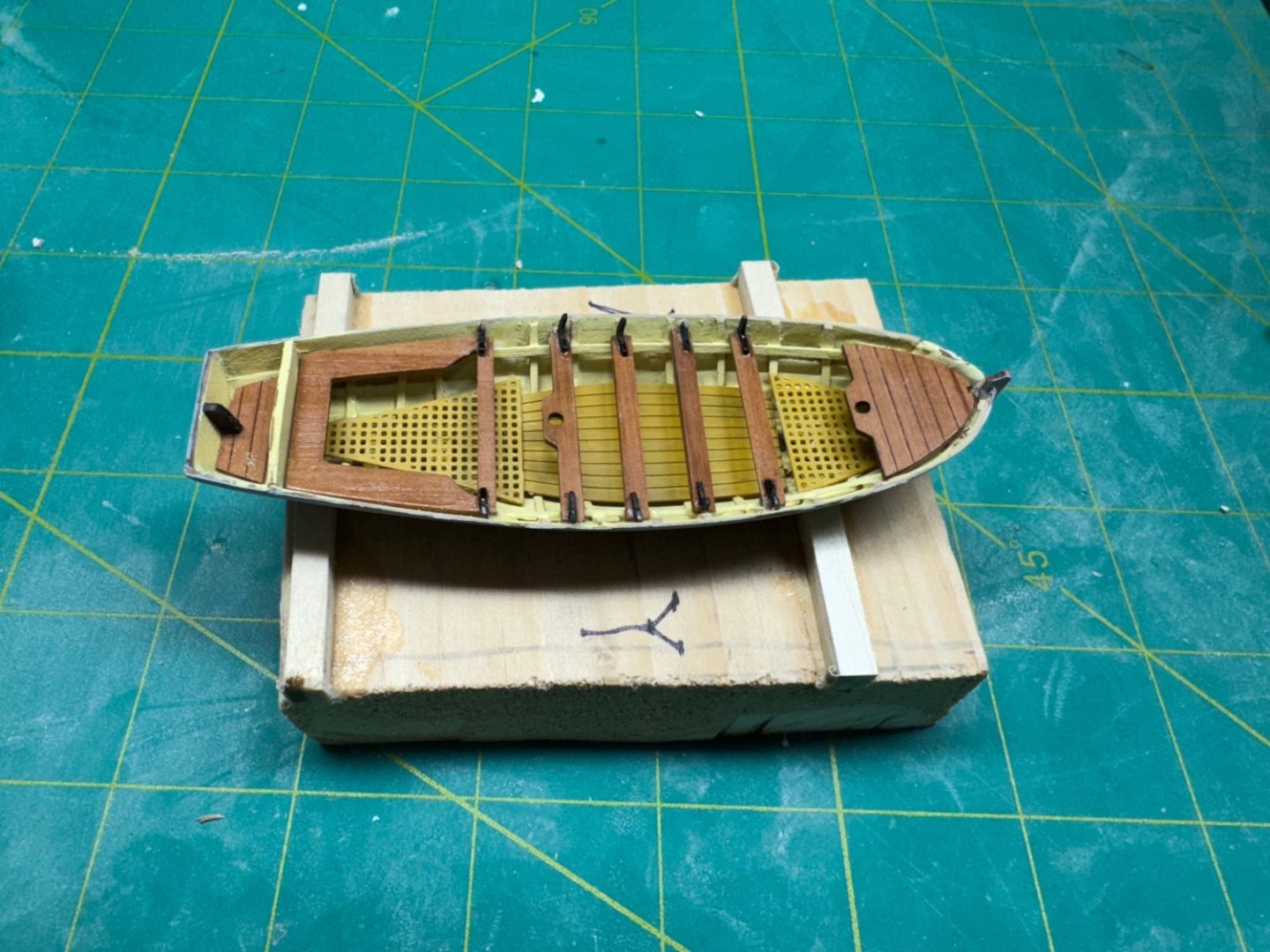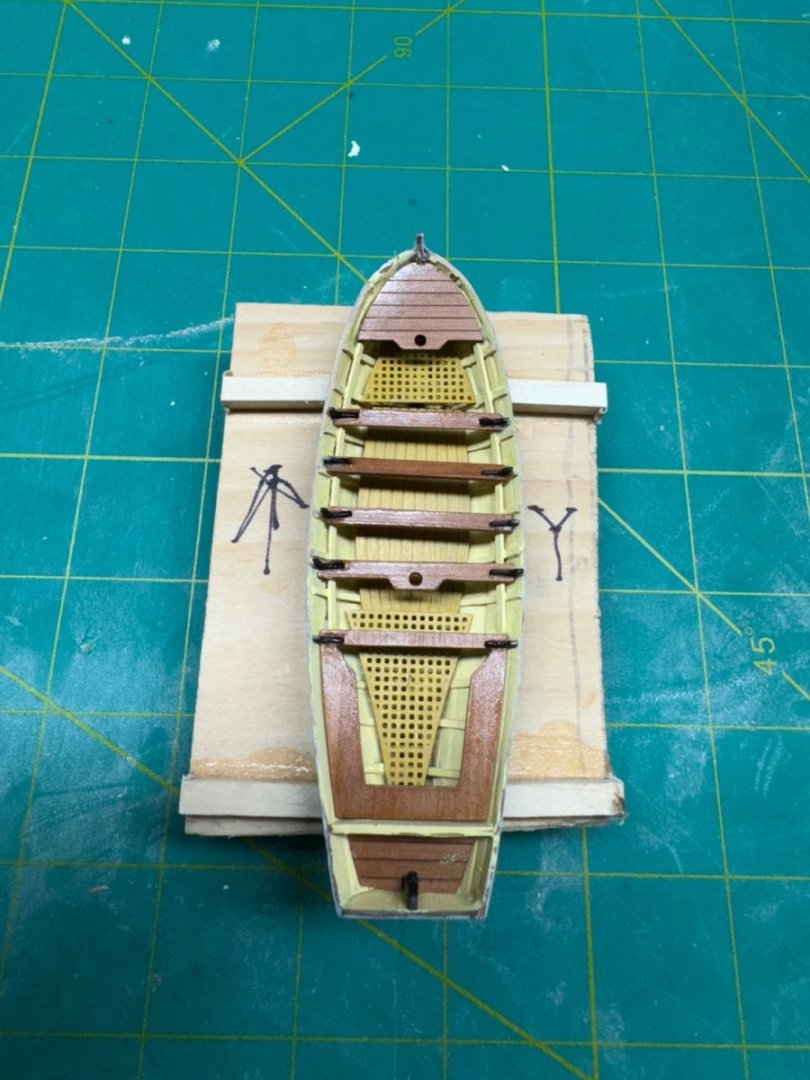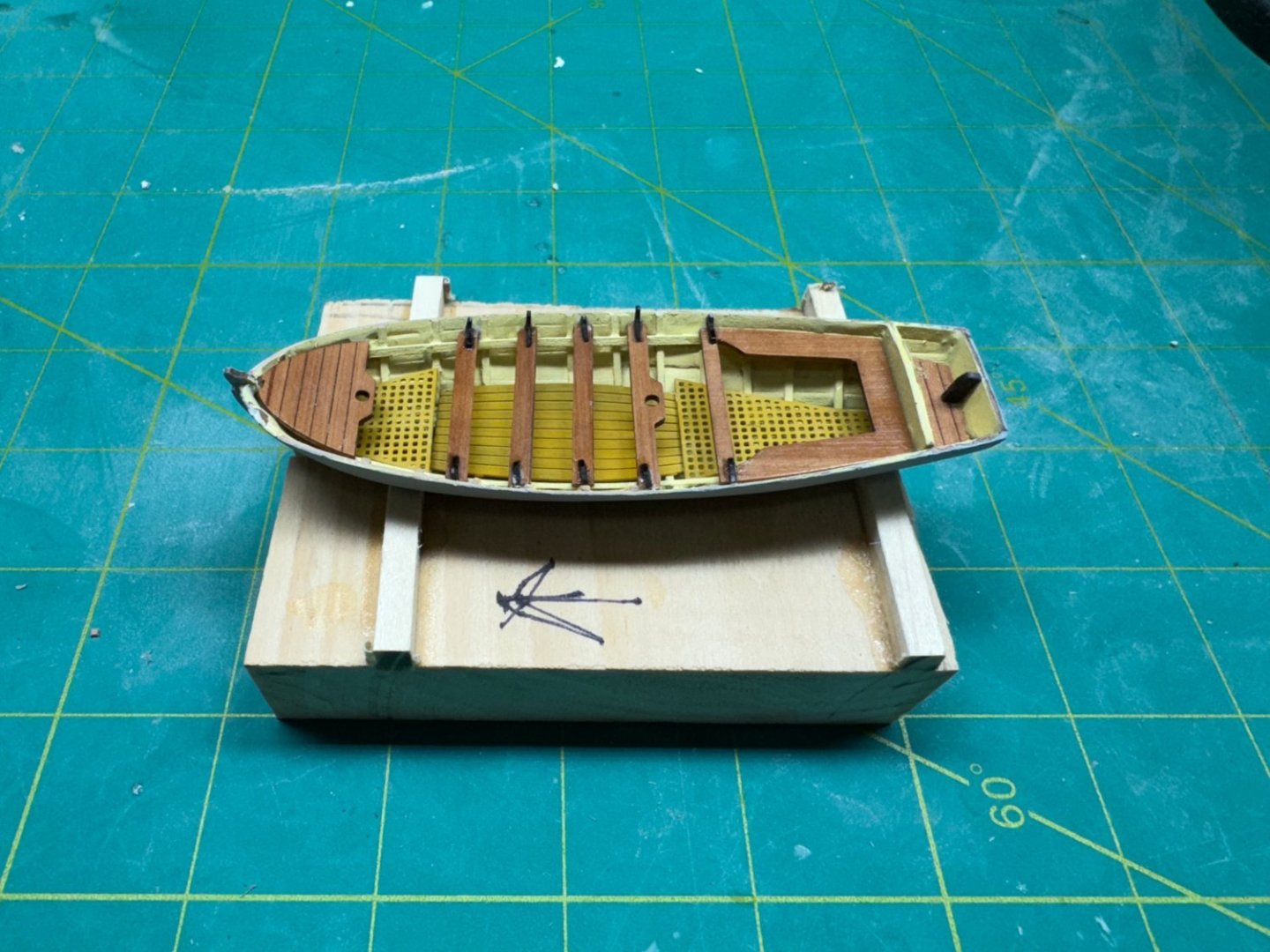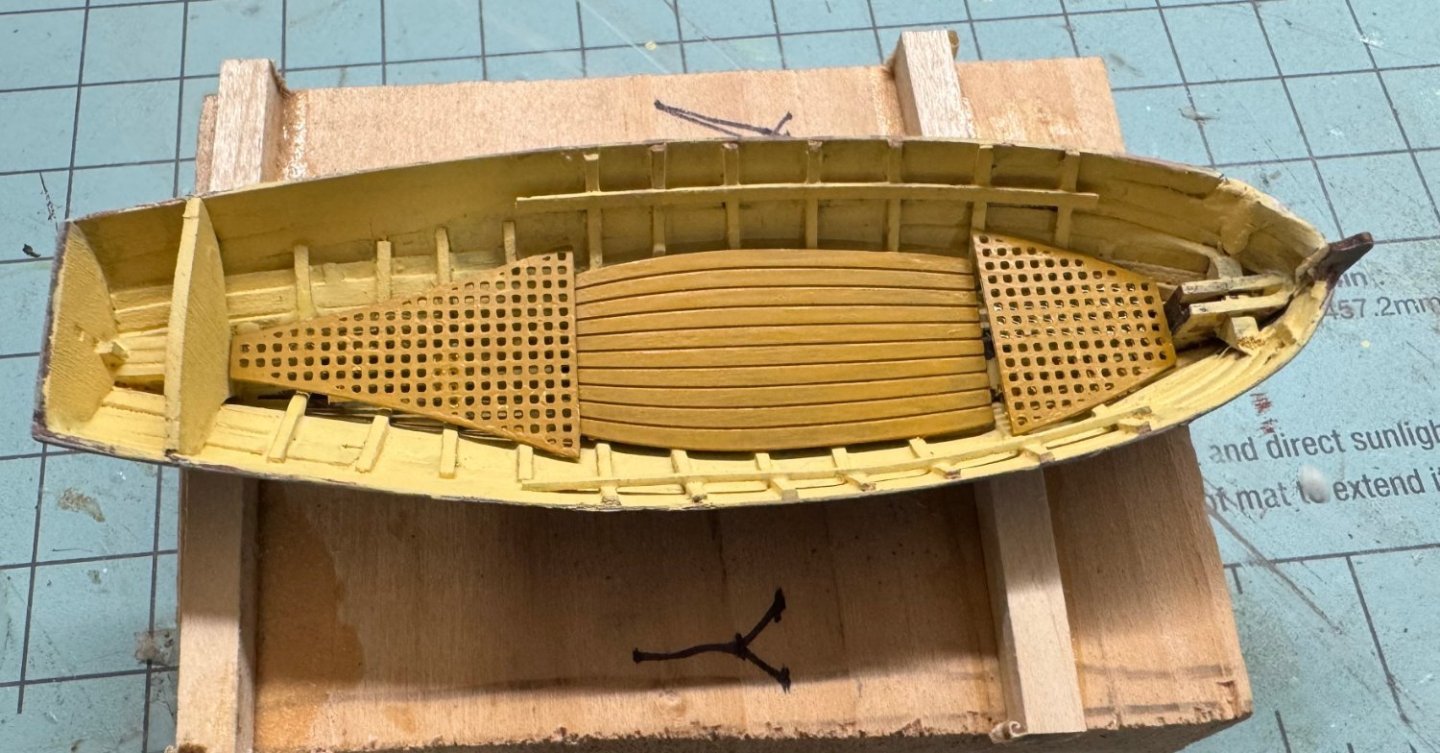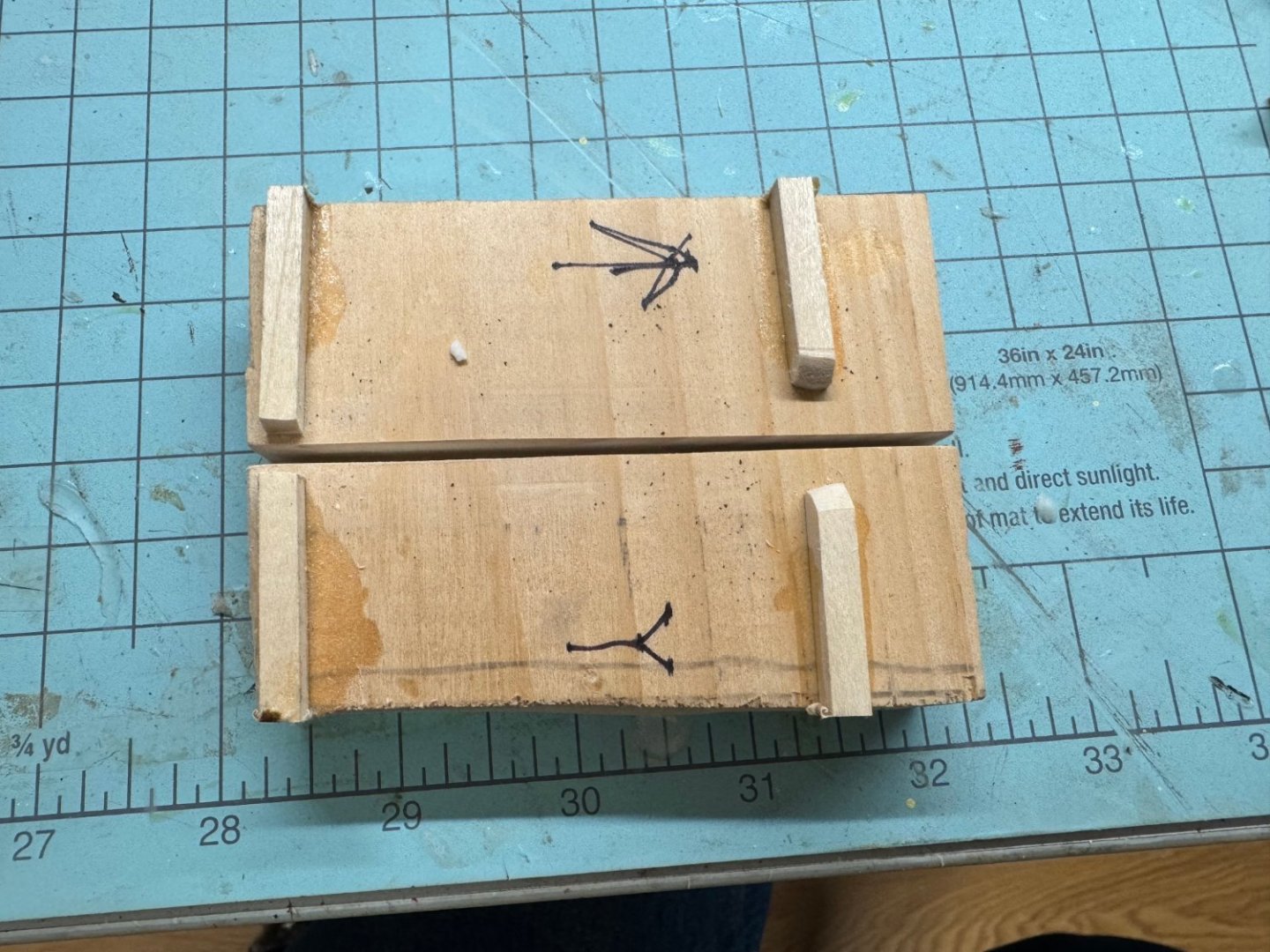-
Posts
1,578 -
Joined
-
Last visited
Content Type
Profiles
Forums
Gallery
Events
Everything posted by cdrusn89
-
Making some progress. Have the cabin hatch and sliders, tank covers, Sampson post (the photo exaggerates the forward slope - it may well be to much but I will see how it looks on the display stand before taking action. Chainplates are next. The sail is finished except foe the reef straps on the other side. These were cut to 1" and I may leave them that long. Trying to trim them (and get them all the same) without pulling them off the sail seems not to be worth the potential damage. I am not sure why the instructions are this way. I am not sure a 3/4" piece would be any harder to handle than 1" but...
- 87 replies
-
- Muscongus Bay Lobster Smack
- Finished
-
(and 1 more)
Tagged with:
-
Sp it is time to build the hull! So I got the bow and stern "assemblies" together without too much trouble although I was scared to death I would glue the formers to the keel that I only put glue on the tabs until I got Bulkhead 12/13 off the keel. Then I painted every junction with diluted PVA. So here is what they look like. I have sanded one side of the stern. Pay no attention to that white glue on the cutting mat - I will clean that up before I quit for the day. I did not use any rotary tools to do what you see on the stern. I did use a Soft-Sander with their 220 grit paper (which is more aggressive than any 220 paper I have seen so far). The shape of the sanding block (and it is flexible (sort of) allowed me to easily find a contour that matched what I (think) I needed to do although with only a picture to go by I might be way off. I think that side needs a bit more work - what you see took about 15 minutes. The Soft Sanders (this is not a commercial - I am pretty sure i saw these on MSW somewhere) come in a variety of contours and since we are not sanding autos or boats you will get half a dozen sanding pads out of one "stick". Hopefully I will have both bow and stern done tonight.
-
Thanks Major - getting the 1mm ones has so far involved buying the set (tools and 100 eyelets, 25 in each of four colors -less than $12 including tax). Maybe somewhere other than Amazon you can get just the eyelets, but then 25 is all I needed for the main and if the jib is in a slightly different color - oh well. Meanwhile back at the hull some more progress and some not so progressive moves. First, the instructions warn that the trailboards are fragile - I completely agree having broken both (shipbuilding god owes me another $1) of them trying to get them installed after painting. I tried to piece them together but was never able to get the joint to disappear - maybe I should have opted for the scroll work to hide the joint but... So anyway I fabed some new trailboards from boxwood, soaked them and clamped them in place to dry. I will probably finish them natural rather than try to paint them. And I installed the cabin roof and painted it white. - going to be at least three coats based on recent experience with this paint. I am going to have the sliding cover in natural boxwood and the slides are from the kit, stained Fruitwood and varnished (WoP) so they should be a close match. All the cleats, oar locks and traveler are installed now. Display stand and all the spars are ready. I fabed and blackened the "chainplates" but can't install until the roof paint job is finished. Need to "build" the jib now that the main is done.
- 87 replies
-
- Muscongus Bay Lobster Smack
- Finished
-
(and 1 more)
Tagged with:
-
Thanks Gregg - I take no credit for originality but to be honest I do not remember where I first saw this. As I said I used it on the 1/35 scale Endeavour and it worked out fine.
- 87 replies
-
- Muscongus Bay Lobster Smack
- Finished
-
(and 1 more)
Tagged with:
-
I managed to get the sail "manufactured" without significant issue, except a little dirt seems to get entrained in the glue no matter how much I cleaned the surface beforehand. Now to the "holes". On a previous build at a slightly smaller scale (1/35) I used metal eyelets instead of just "holes" in the sail. Less chance of to hole not staying the drilled size or the line pulling through the material if it is pulled too tight. Plus it is pretty much what the "real" boat had. These are 1mm eyelets (from Amazon, although you have to look carefully through the "1mm eyelet" search results to actually get 1mm eyelets). This set includes the tools necessary to install them too. Since I can't really measure the inside diameter mof the eyelet easily I measured the outside diameter of the "barrel" at 1.6mm so a wall thickness of 0.3mm would have the interior opening at 1mm or about 1" at full size. Certainly not too big. First you need the hole and for that they provide a "punch". I used a scrap piece of wood under the sail while I punched the holes. Sometimes it took several "hits" to get all the way through as there are three or four layers of "sail" in some places The "plug" is held in the punch until enough accumulate then they fall out a slot in the tool. You insert the eyelet (not that easy, I use an awl to put the eyelet on then use that to get the eyelet through the hole. The eyelet is then placed on the anvil and the other end "mushed over" by striking the end of the "mushing tool" shown on the left below. This eyelet has already been mushed but you get the idea. Using a small jewelers hammer it takes five to eight strikes to get a proper "mush". The real trick (for me) is making sure the eyelet is properly seated on the anvil. I put the mush tool on the eyelet and try and move the anvil. If it is seated properly it should not move, otherwise relocate the eyelet and try again. Here is the bottom of the sail with all the eyelets installed.
- 87 replies
-
- Muscongus Bay Lobster Smack
- Finished
-
(and 1 more)
Tagged with:
-
So I decided to see about the already constructed cannon that I have "in storage". As I recall these were supposed to go on the Confederacy (I did not like the Model Shipways cannon for some reason) but were too tall to fit through the gun port. (and I never thought about sanding the wheels down a bit) And as it turns out I have exactly twenty of these all ready to go, including the breeching tackle. I went ahead and built one of the cannon that come with the Sphinx kit (which I might add are somewhat different from what Vanguard sells on their site - at least what they were selling last year). Here they are side by side: Overall the ones I have (which are Syren Ship Model Company products by the way) are about 1/8" longer. The cannon is narrower although the Syren guns are "advertised" as being 12 pounders while Sphinx carried nine pounders. Since the issue on Confederacy was height I used my handy dandy height gauge and here is what I found: The Syren cannon are about 1.6mm (aka .065") taller. The real question that I will not be able to answer for some time: is this too tall?? End result I wait until I have a gun deck to measure before I build any more cannon. On to the hull. 😃
-
While waiting for the glue to dry on the sail material I tackled the traveler and associated block. I did not see a way to avoid using metal stropping on this block. A rope eye on the traveler would not last very long. Not a big fan of the technique in the instructions (mostly because I have never been able to make it work as nicely as the instructions). So I tried another tack. In my pile of material I have eyebolts which I believe I got from Model Shipways several years ago (pre-Pandemic). A quick look at their website does not show these now; they are about 1 1/8" long. I drilled a hole in one end of the block just big enough (#70) to fit the eyebolt shank. I drilled the hole deep enough to pass through the channel where the rope has to run but not all the way through, not quite half way. I cut the shank of the eyebolt so just the eye was exposed, inserted the eyebolt and added a drop of thin CA. Then I used a #68 drill to drill through the rope channel that is now blocked by the eyebolt shank. Hopefully there is enough material in the upper part of the block for the thin CA to hold the eye in place. Another drop of thin CA can't hurt. Then I bent the shank at was removed in a "U" and glued it on the sides of the block. I had a old piece of 1/16" brass rod (all the shine was long gone) and slipped the eye over the rod after it was bent to the shape in the instructions and check fit on the hull.
- 87 replies
-
- Muscongus Bay Lobster Smack
- Finished
-
(and 1 more)
Tagged with:
-
Thanks - I will be glad to get these behind me. Am considering doing the cannon next instead of the "real" ship. I really hate stopping the hull construction in the middle to open the armory. I may have some cannon that will fit already made from a previous error in not checking sizes accurately enough but will get the Pinnance finished then move on to the cannon or the hull.
-
Time to make sails while the hull gets a new paint job - with the beakhead on this time. I looked at the sail plan and "on a lark" laid the boom up against the sail. Wow - the sail looks to be a panel too long. If the stop cleats are to hold the outer end of the sail, as the pictures in the instructions show then this sail would be way too big. I checked the boom against the drawing and it is "spot on" so I will cut the sail one panel shorter than the plan. If I cut the main one panel shorter I may have to shorten the gaff a bit of at least move the stop cleats forward a bit. Glad I measured and did not just cut to the plan. Could have been worse, sail could have been too small, then cutting first would have been a REAL problem.
- 87 replies
-
- Muscongus Bay Lobster Smack
- Finished
-
(and 1 more)
Tagged with:
-
Here they are after blackening and with the larger set for the shrouds. I used these on my 1/35th scale Endeavour and they did not look out of scale there so here at 1/24 they should be okay. I got them from the ShipWrightShop.com in the UK so shipping is expensive and the small ones are about $3.50 each (5.40 UK Pounds for two).
- 87 replies
-
- Muscongus Bay Lobster Smack
- Finished
-
(and 1 more)
Tagged with:
-
I have the coaming and cabin sides in place and while waiting for the cabin roof to "dry and take shape" I started working on the rigging. I believe that one should attempt to get as much of the rigging as reasonably possible done before the spars are attached to the hull. To this end I attached the blocks to the boom and gaff. Attached the two blocks with lines attached and the single block to the mast. And the block and turnbuckles to the bowsprit. And yes you are correct those are not the kit provided turnbuckles - these actually work. Will come in handy to "tune" the rigging when that time comes. They are not cheap (~ $2.50 each) and are made by Caldercraft. Probably a bit out of scale here but would be about 2.5" in diameter at the widest point at full scale so not completely unreasonable (IMHO). I will probably chemically blacken them or at least tone down the shine before actually using them.
- 87 replies
-
- Muscongus Bay Lobster Smack
- Finished
-
(and 1 more)
Tagged with:
-
While working on the wales on the other two boats I wanted to make a recommendation for those who build these later. On both the Pinnance and Yawl the wales are located on top of the second plank down from the sheer. On the Launch they are on the sheer and the oar "locks" are created by short sections of planking above the sheer plank(s). So I recommend that on the Yawl and Pinnance that the wales be installed after painting the hull but before the seat installation and other interior "furnishing". Here is the Pinnance ready for seat installation: It will be much easier to get the clamps necessary to hold the wales down while the glue dries without the seats etc.getting in the way. Don't ask me how I came to this realization. On the Yawl I had to use clothes pins that were sanded down narrow enough to fit between the seats and they were not really strong enough to pull the wales into the hull curvature at the bow. I eventually had to soak the wales pieces and bend them on my duty plank bender to get them in place. So - add the wales on the Pinnance and Yawl BEFORE adding the seats etc.
-
5/16" Boxwood blocks and 12mm Boxwood cleats with .025" phosphor bronze "pins" to increase stability. Some of these will actually have to sustain a load not just be ornamental. Blocks will be stropped with line rather than wire - I find it easier and neater and makes attaching them to an eyebolt easier. I have little faith in the holding power of PE or vinyl hooks. Both items are from Syren Ship Model Company.
- 87 replies
-
- Muscongus Bay Lobster Smack
- Finished
-
(and 1 more)
Tagged with:
-
Cabin sides and coaming fitted and the coaming is glued in while the cabin sides are drying. Holding the cabin side down in front makes the sides want to flare out so the two toothpicks and rubber band are trying to keep them vertical. Paint scheme is still "under consideration". but I think cream inside the cockpit including the cabin front and access door (to match the floor) and the same light blue as the deck for the outsides of then coaming and the cabin walls. For the cabin roof I think white or off-white and maybe the cream or the dark blue for the cabin roof access slider and the tank tops.
- 87 replies
-
- Muscongus Bay Lobster Smack
- Finished
-
(and 1 more)
Tagged with:
-
Yawl is DONE!!! Complete with anchor (and rode although you can't really see it, I know it is there), three sets of oars and two boat hooks. I seriously doubt that the boats were stored with the rudders in place - too hard to keep them secure and they are a very critical component but since the supplied rudder include integral pintles and gudgeons I decided to put the rudder on. Now if I can get the tiller to point dead ahead...
-
I have deferred installing the rub rail because I am not completely satisfied with the hull paint job and may do it over after the rest of the deck materials are installed - that is when the instructions would have you paint the hull anyway. So I fabricated new oarlock pads and Sampson post from boxwood to keep the topside materials consistent. Here they are after the first coat of WoP. I did notice that the oarlock pads pictured in the instructions appear to be considerably thinner than the ones provided which are about 3/32" tall. I also added the fair leads at the bow, also of boxwood - they still need WoP in the "grooves and at the rounded end aft. Working on the cabin coaming - I decided to try and get the coaming bent off the ship - I have a feeling that trying to get it both bent and fitted at the same time might be more problems than doing them one at a time.
- 87 replies
-
- Muscongus Bay Lobster Smack
- Finished
-
(and 1 more)
Tagged with:
-
I got the launch completed through the seat installation. Maybe tomorrow I will try and get the knees installed - 18 by my count (two on each side of the two seats where masts will be fitted). Should be much fun. I will paint the hull before installing the wales and the bulkhead supports at the oar locations - drawing would sure help to figure out where those are more exactly than just using the photos in the instructions!! Note - I broke (the gods of model ship building owe me another $1) the aft seat structure twice. I had to add a support under the second break to keep the two sides more or less level. My plan is to put all the oars in the center of the boat to hide the added support and hopefully where the two breaks are located. I also broke both of the seats with the mast cutouts but made replacements for those from the excess material on the carrier sheets. They need several more coats of WoP so they "match" the others.
-
Kurt - you are correct, glue the planks together edgewise and not to the frames. That presents something of a challenge in trying to get the planks to conform to the shape of the frames without attaching them. I suggest you invest in a bunch of rubber bands and some scrap sanding sticks to use as leverage to put pressure on. the planks while the glue (I used slightly diluted PVA) dries. I say sanding sticks because the sandpaper helps grip the planks. Otherwise the leverage sticks tend to slide in whatever direction the rubber bands pull them which, as luck would have it, is usually in an undesirable direction.
-
A word about knees. I had the devils own time getting them on the yawl. I painted them black (using a blunt Sharpie, easier and faster than paint), tried to get them in place with PVA but eventually settled for thin CA. Use a half needle applicator and hold the knee in place with the tweezers in one hand and the CA applicator in the other. They are very small and it is not obvious from the instructions which way (long side on seat or on bulkhead) they should go. I finally figured out it must be long side on the seat, otherwise they would stick up even more than they do, at least on mine. I have to assume that my seats are higher (but I carefully measured the directed 3mm down from the gunwale) or there is something else working here of which I am not aware. It would be really nice if there was a drawing of each of the boats somewhere. Where exactly the seats are supposed to go is "left to the student" with only the pictures in the instructions to go by. A drawing would also help locating the ribs. Spacing them 5-6mm apart per the instructions leaves a lot of room to both get out of sync between the two sides but also mess up the seat spacing. On the yawl I had to put seats where there were ribs which is not how it is supposed to work as best I can tell from the pictures. On the yawl I finally fixed the forward and rearward most seats from the pictures (but could easily be off a mm or two) measured the remaining distance and spaced the two middle seats so they are equally spaced. With six and seven seats on the other two boats that may not work as easily - I am poor at math. I just looked at the knees for the Launch and Pinnance and they are even smaller than on the yawl. And there are more of them; 14 on the Pinnance and 16 on the Launch. I am considering gluing them on the seats before they are installed on the boat and not painting them black like in the instructions but leave them "natural," laser char and all - I can't imagine trying to get the char off something sooooo small).)
-
The yawl with the seats and such installed. And yes I know that gloss finishes were not used in this time period but I could not resist some shiny surfaces - it is a boat after all. Next is the gunwales on each side and the stern then then hull paint and wales. The Launch and Pinnance are coming along nicely.
-
Kurt - I have started building Sphinx (my first vanguard kit) but started on the ship's boats. I did not want to get to the end and then have to build the boats to finish. I followed a similar strategy on Confederacy and Winchelsea (although the ship's boat was not part of the original Winchelsea "kit"). Perhaps I am just to set in my ways. I will let you "lead the way" going forward.
-
Much as would have liked the suction vises to adequately hold the boats such was not the case. Try as I might they would not stay secure or even a reasonable approximation of secure while I added the ribs. So I resorted to more "primitive" methods. I cut a slot in a scrap piece of wood, fashioned some supports from square stock scraps and there is the yawl base. Y = yawl and the arrow points forward since the supports are "tailored" to some extent. Since the hulls do not yet have there finish coat of paint I use rubber cement to attach the hull to the base. And here is the yawl after interior painting and floorboard installation.
About us
Modelshipworld - Advancing Ship Modeling through Research
SSL Secured
Your security is important for us so this Website is SSL-Secured
NRG Mailing Address
Nautical Research Guild
237 South Lincoln Street
Westmont IL, 60559-1917
Model Ship World ® and the MSW logo are Registered Trademarks, and belong to the Nautical Research Guild (United States Patent and Trademark Office: No. 6,929,264 & No. 6,929,274, registered Dec. 20, 2022)
Helpful Links
About the NRG
If you enjoy building ship models that are historically accurate as well as beautiful, then The Nautical Research Guild (NRG) is just right for you.
The Guild is a non-profit educational organization whose mission is to “Advance Ship Modeling Through Research”. We provide support to our members in their efforts to raise the quality of their model ships.
The Nautical Research Guild has published our world-renowned quarterly magazine, The Nautical Research Journal, since 1955. The pages of the Journal are full of articles by accomplished ship modelers who show you how they create those exquisite details on their models, and by maritime historians who show you the correct details to build. The Journal is available in both print and digital editions. Go to the NRG web site (www.thenrg.org) to download a complimentary digital copy of the Journal. The NRG also publishes plan sets, books and compilations of back issues of the Journal and the former Ships in Scale and Model Ship Builder magazines.



